Art transports us, engages us, provokes thought, summons deep emotions, mirrors experience, and, most often, is simply beautiful.
Whether viewing art or creating art, the relationship between art and the brain is undeniable.
Inspired by neuroscience research at the Friedman Brian Institute, the Art of the Brain exhibition, created and curated by Veronica Szarejko, Director of the Art of the Brain, is a collection of photographs, illustrations and sculptures that celebrate the beauty of the brain as seen through the eyes of some of the world’s leading researchers and medical illustrators. With the aid of the latest technological advances, scientists are better able to understand how the brain works and to accelerate the development of new treatments for many brain disorders including Alzheimer’s disease, autism, drug addiction, schizophrenia and Parkinson’s disease, among many others. Whether an “accidental” element or an intended consequence, the byproduct of this research, the pieces that make up the Art of the Brain exhibition, offer an “explosion of vibrant colour and intricate detail, evoking chaos and calm, beauty and pain…” An experience that “is about being human; the remarkable microscopic activity that makes us living feeling beings—cognition, emotion, sensation, perception.”
Born from the Art of the Brain exhibition, the Art of the Brain Lecture series features an exciting array of experts from within the science and art communities with whom we explore the intersection of art and neuroscience and the variety of ways in which this convergence impacts people on both a neurological level and the level of human experience.
Both the Art of the Brain exhibition and the lecture series expand the Friedman Brain Institute’s reach beyond an academic/scientific setting to laypeople of all ages connecting the Friedman Brain Institute with its East Harlem community on a visceral level as they “offer many perspectives, interpretations and insights” into the human condition.
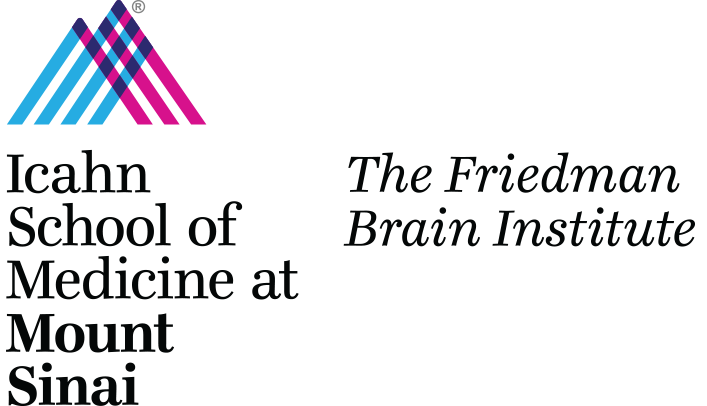
Holly Oemke Madarash
Emerge
Department of Neurosurgery
3D visualization of a patient’s intracranial anatomy with tumor for surgical planning.
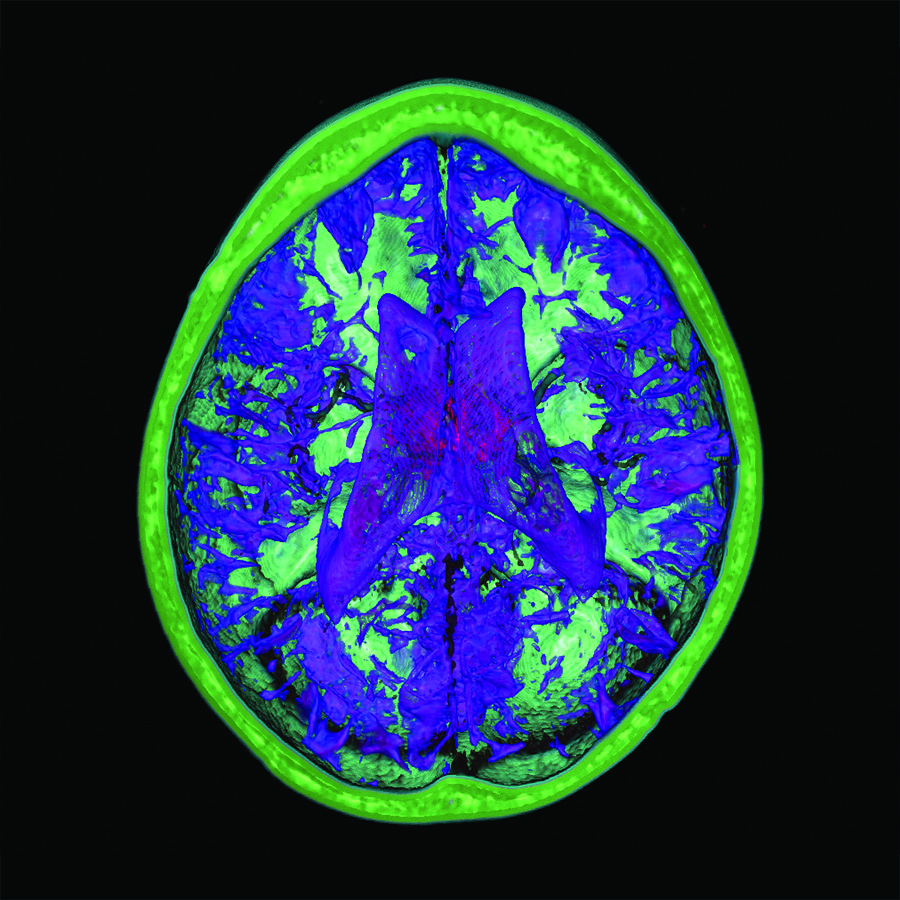
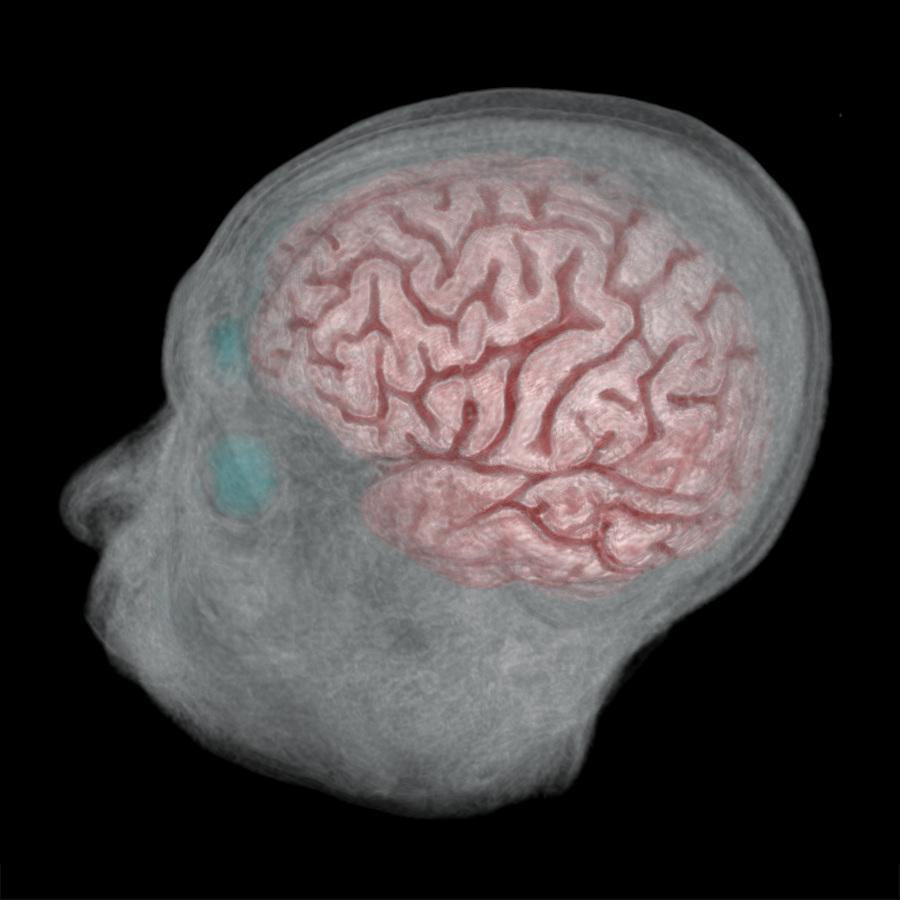
Holly Oemke Madarash
Emerge
Department of Neurosurgery
3D visualization of a patient’s intracranial anatomy with tumor for surgical planning.
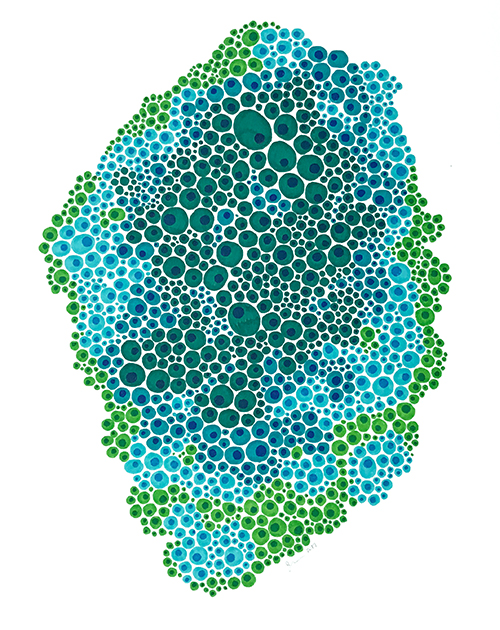
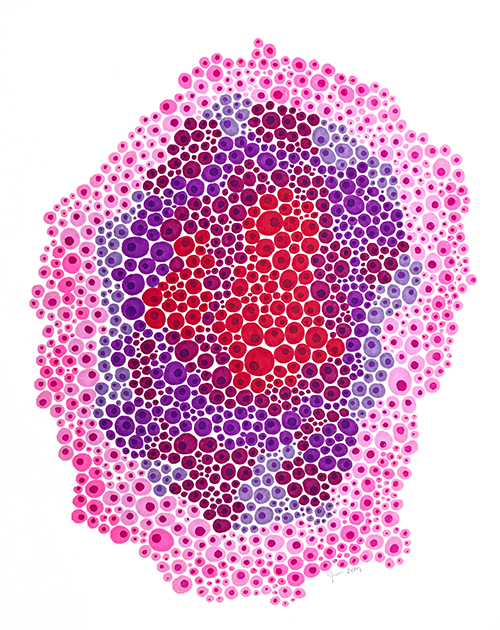
Jessica Johnson, MFA, MPH
Department of Genetics and Genomic Sciences
Untitled (Cells #4)
Abstract depiction of cells under a microscope.
Jessica Johnson, MFA, MPH
Department of Genetics and Genomic Sciences
Untitled (Cells #2)
Abstract depiction of cells under a microscope.
Shalaka Wahane, PhD
Nash Family Department of Neuroscience
Astra
Astrocytes – one of the more abundant cell types from the mouse brain are cultured
in the lab and imaged using the astrocyte marker GFAP
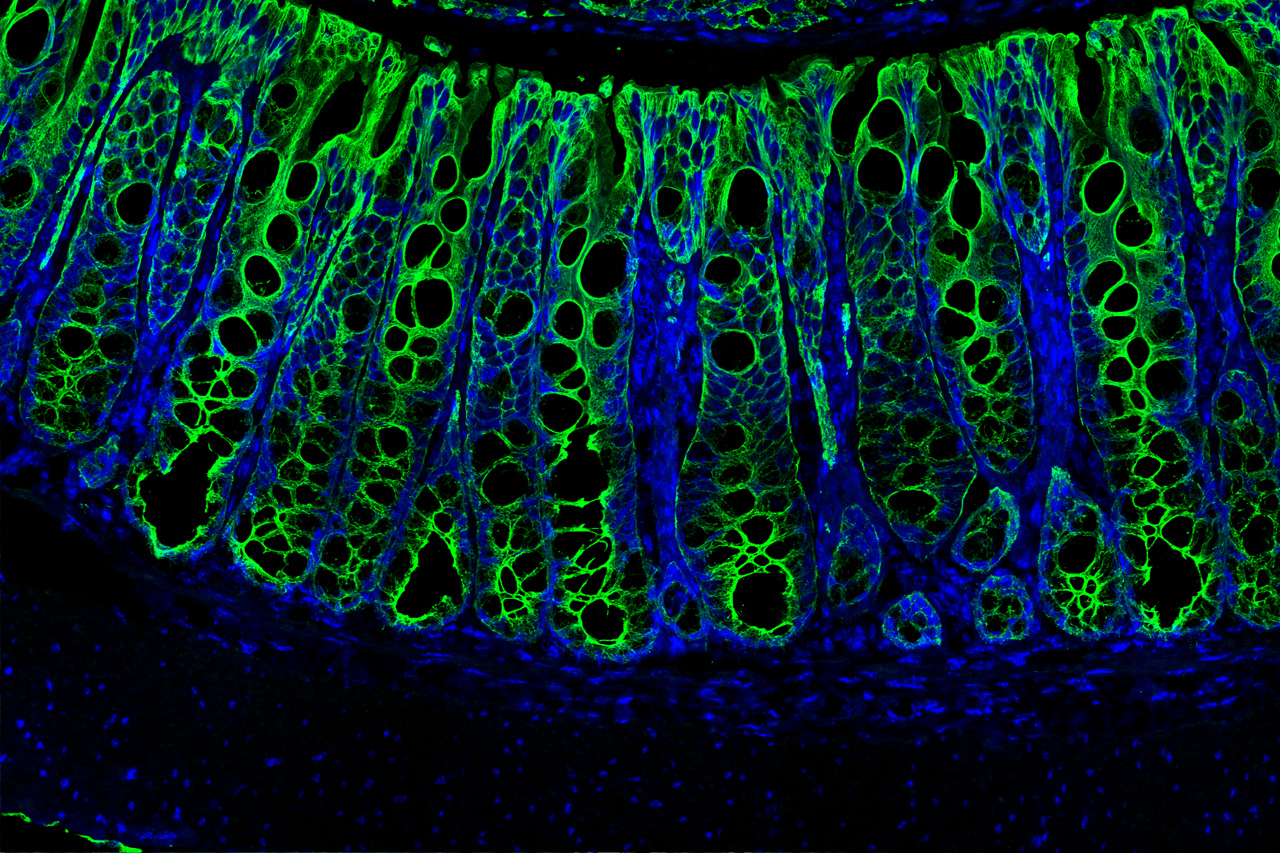
Kenny Chan, PhD
Nash Family Department of Neuroscience
The Second Brain
Assessment of cell death in the large intestine following chronic stress. “They say the gut is the ‘second brain’, as it acts as an interface between the host and environment, where nutrients and commensal bacteria can influence mood and behavior.
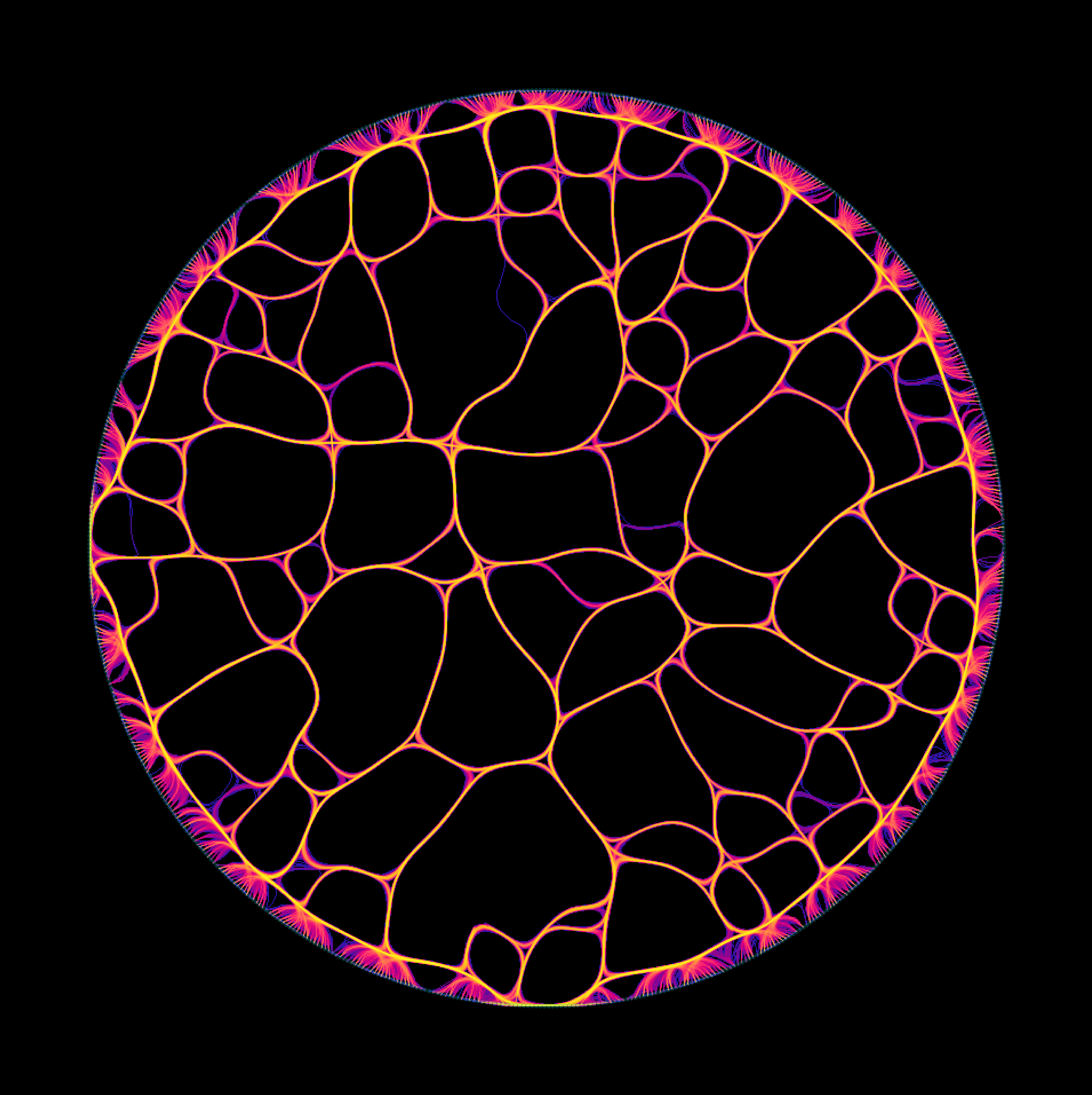
Brian Schilder, M.Phil
Department of Genetics & Genomic Sciences
Wildfire
Transcriptomic data from 16k+ individual brain cells (shown as points) after reducing the dimensionality with an autoencoder and UMAP. 5 million tracts are shown interconnecting these cells, where shorter tract length represents greater similarity in their molecular profiles.
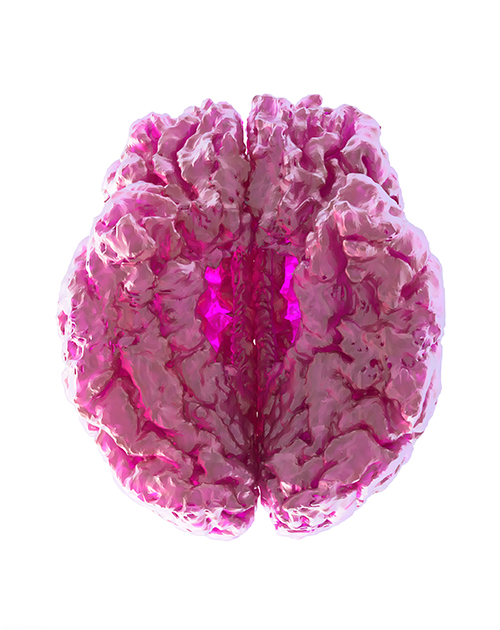
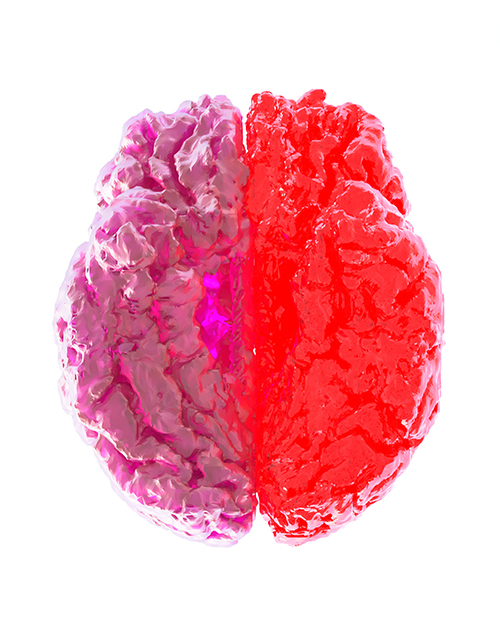
Jacob Wolf
Department of Neurosurgery
Hot Thoughts
MRI of Joe Borrellos Sliced and Renderd In CAD and manipulated in Photoshop.
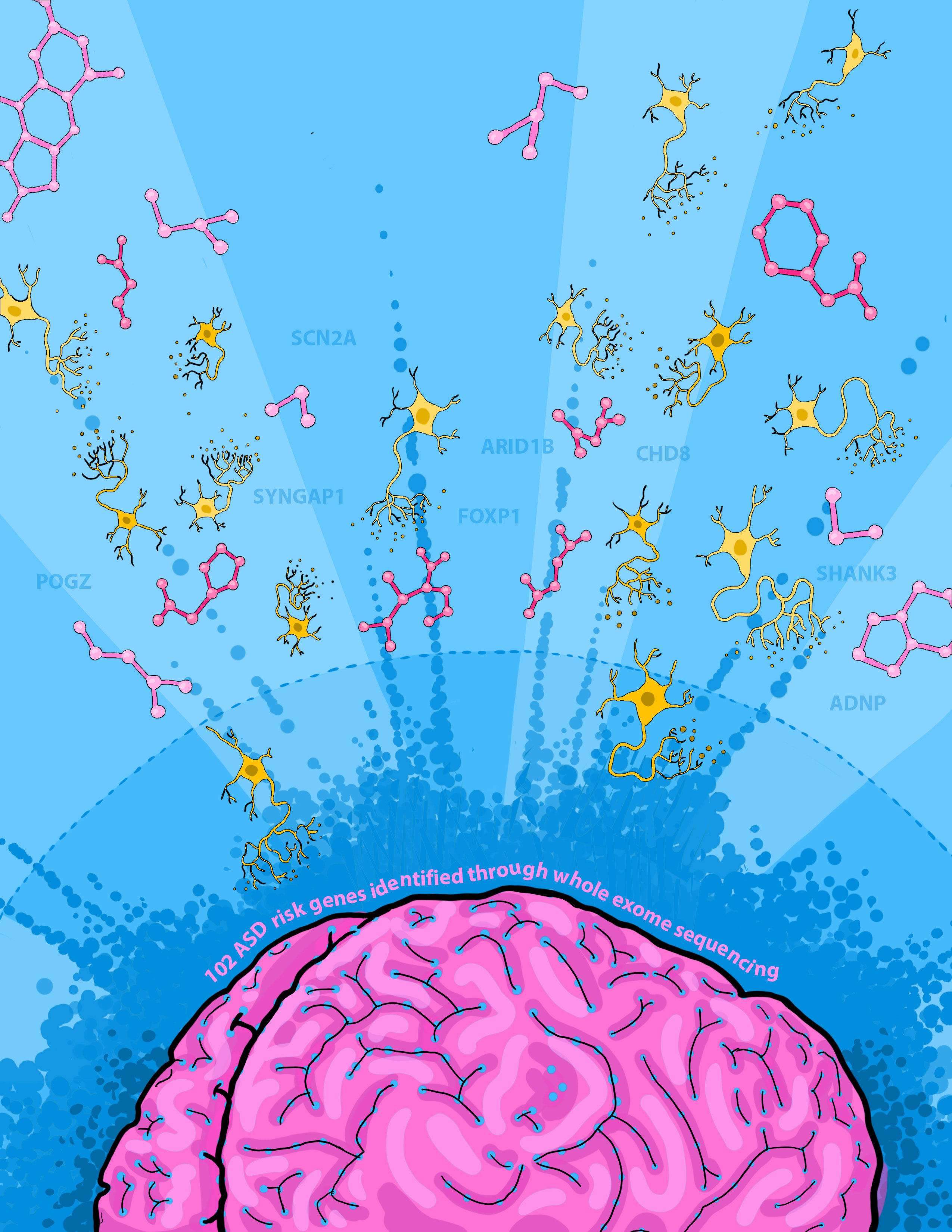
Jessica Johnson, MFA, MPH
Department of Genetics and Genomic Sciences
102 ASD risk genes discovered through whole exome sequencing
Artist depiction of a manhattan plot of 102 newly-identified ASD risk genes with neurons
and molecules depicting different functional groups
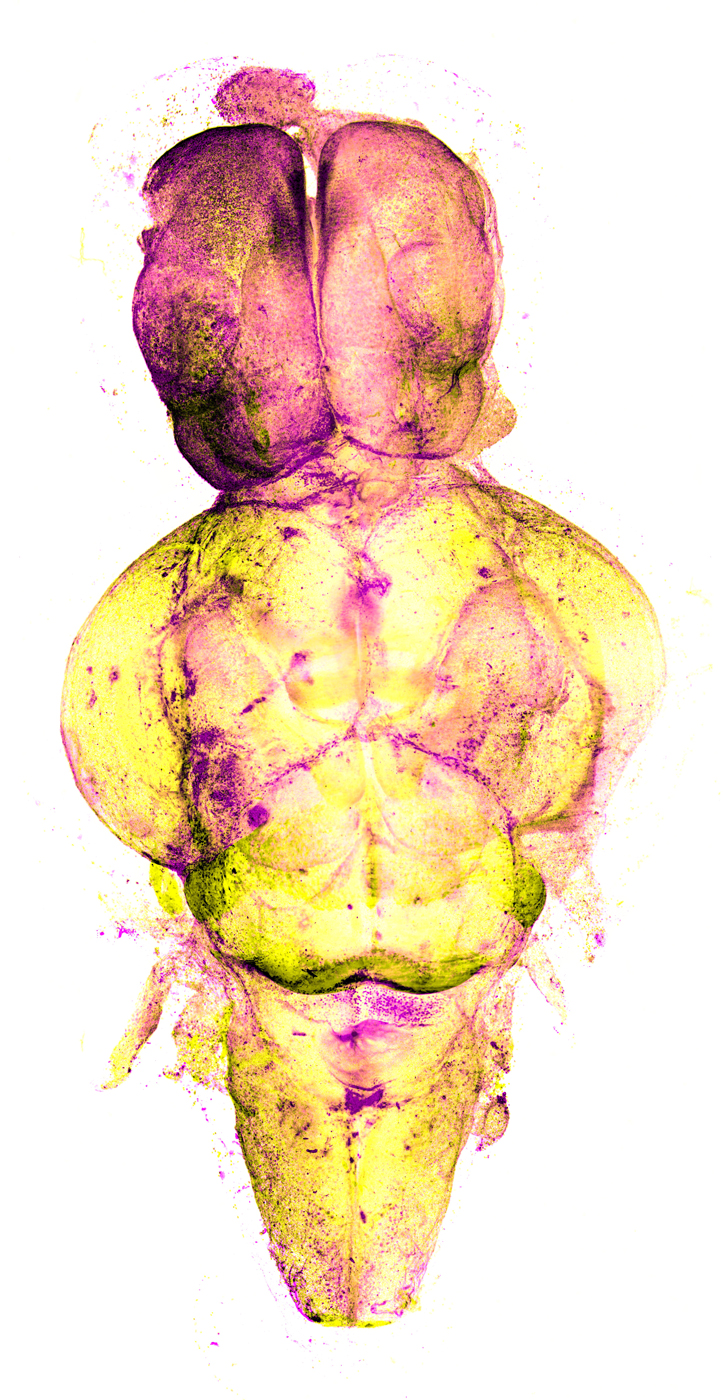
Paloma Bravo, MS
Department of Cell, Developmental and Regenerative Biology
…am I being clear?
Microglia in adult female zebrafish brain
Anirudh Sattiraju, PhD
Enablers
Nash Family Department of Neuroscience
Tumor-associated Macrophages (TAM) (white) infiltrate an aggressive glioblastoma containing numerous hypoxic tumor cells (green).
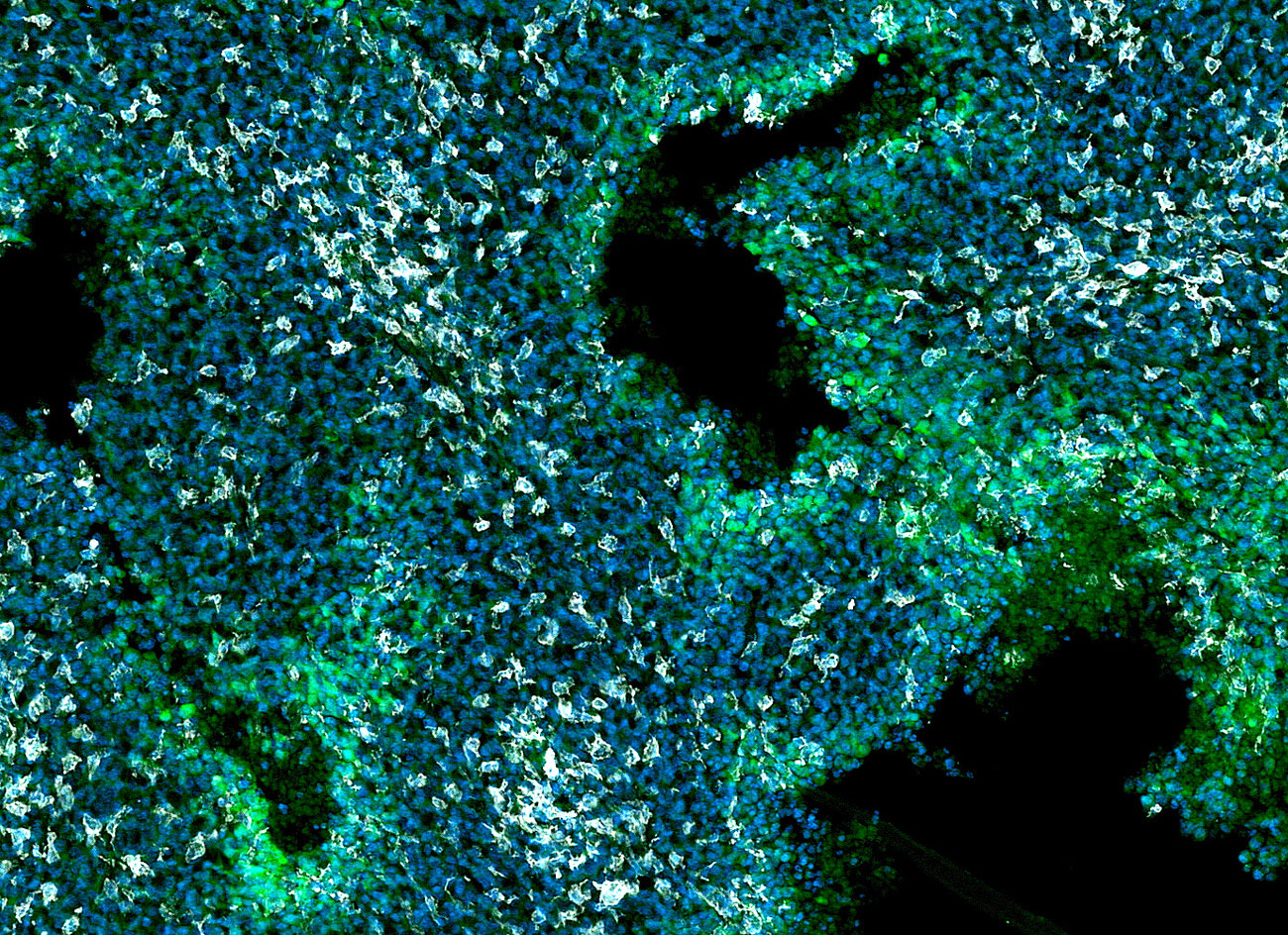
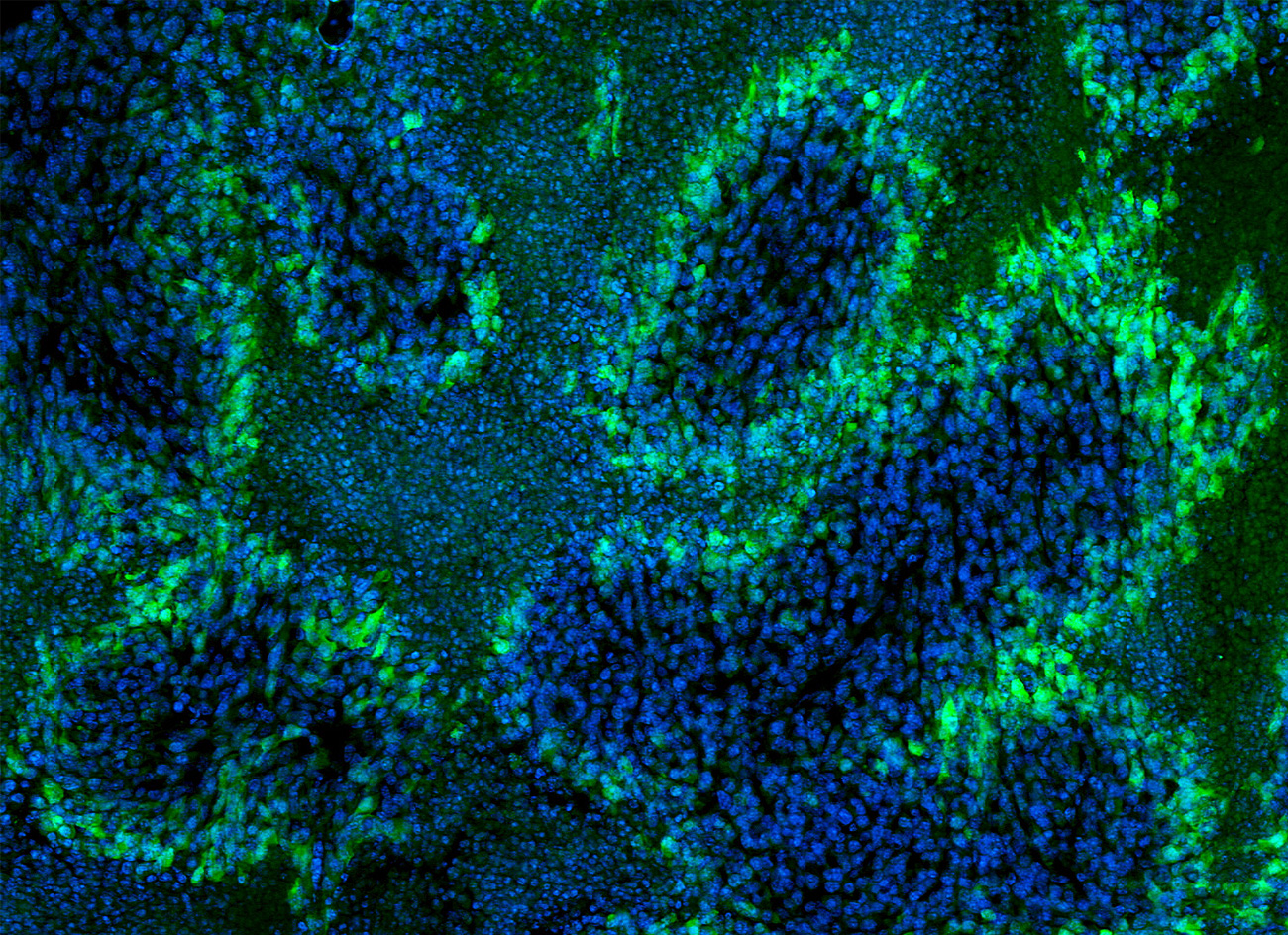
Anirudh Sattiraju, PhD
Unsustainable desire to proliferate
Nash Family Department of Neuroscience
Hypoxic glioblastoma cells, that have been engineered to fluoresce (green),
separate necrotic tumor tissue from healthy tumor cells (blue).
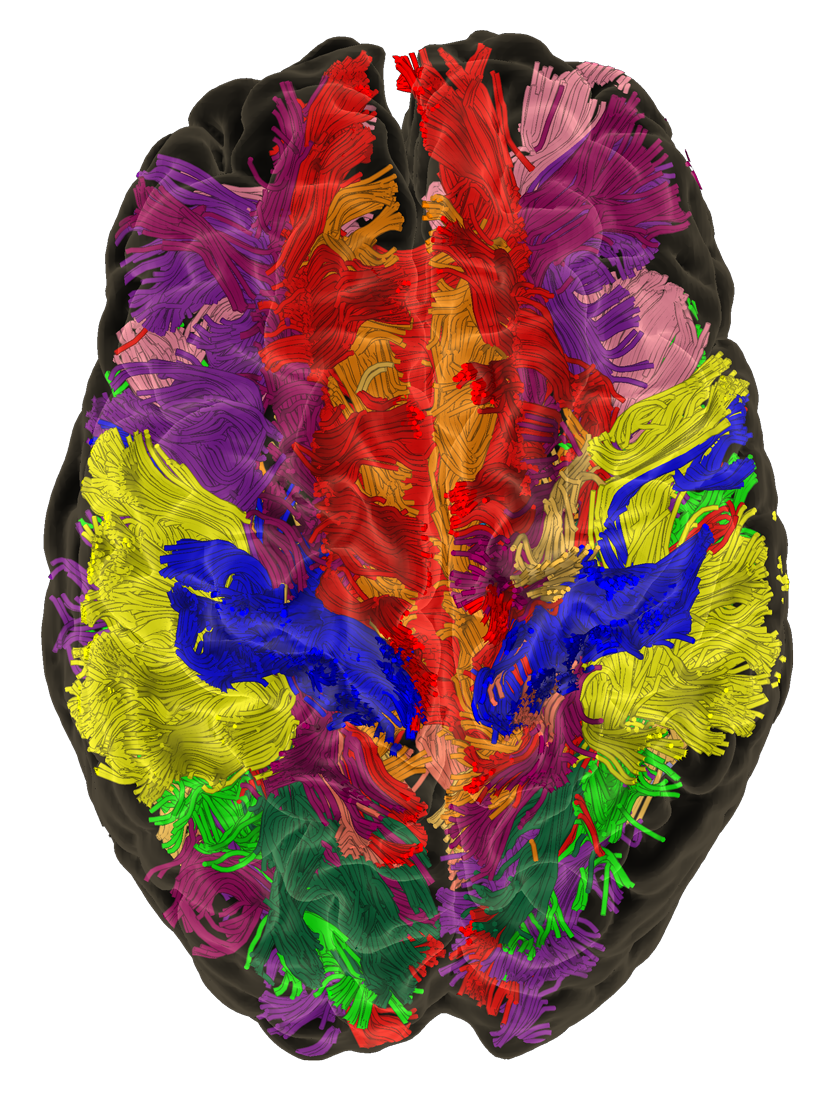
Leslie Schlachter PA-C
Department of Neurosurgery
Elegent Eloquence
Segmented bundles of cerebral tracts in a normal brain.
NFS
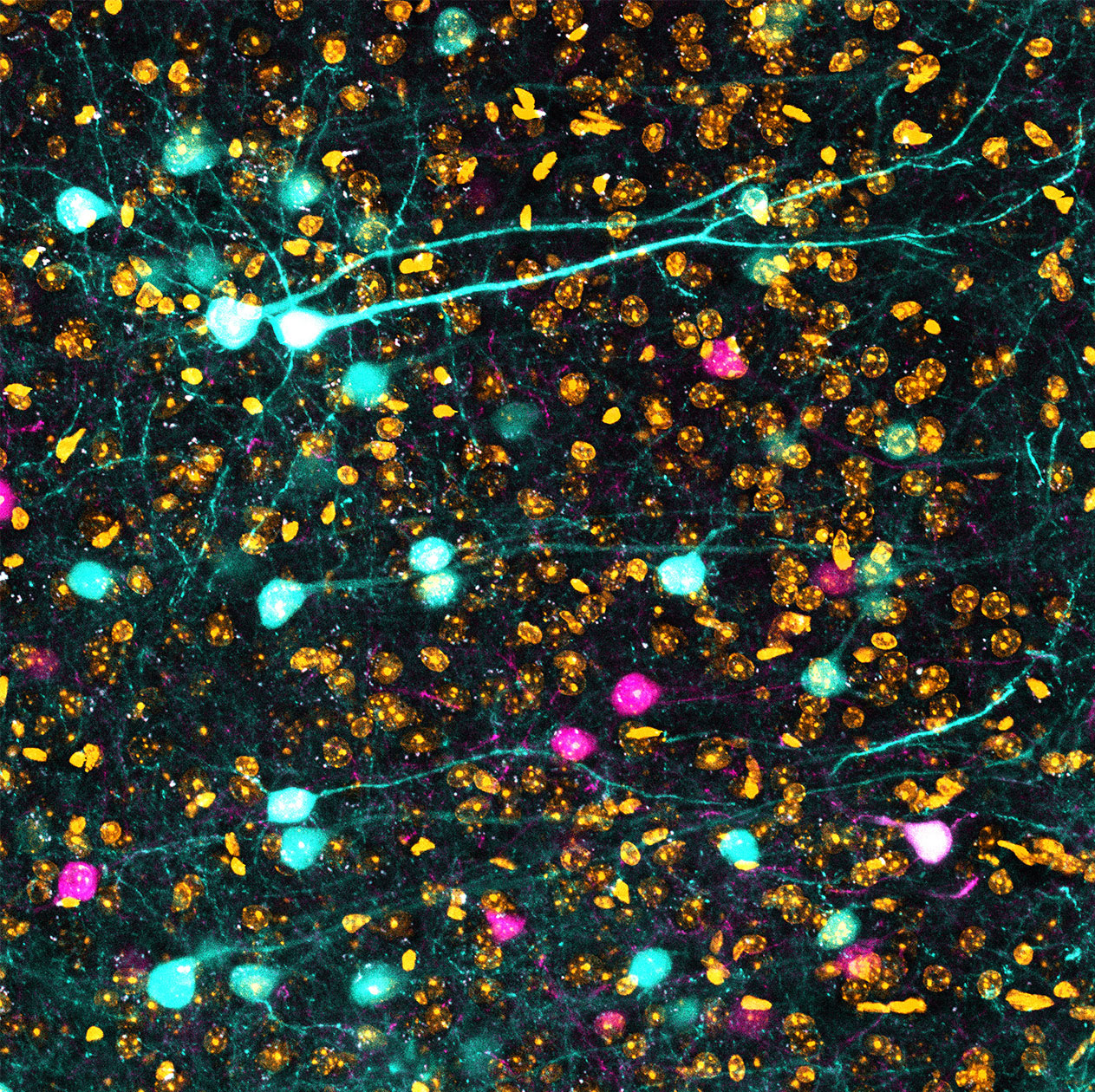
Long Li, PhD
Nash Family Department of Neuroscience
May the 4th be with U
Local infection of excitatory neurons(1st panel blue color) and their input neurons
from hippocampus (green neurons in the other 3 panels, the red ones are projecting neurons to LS).
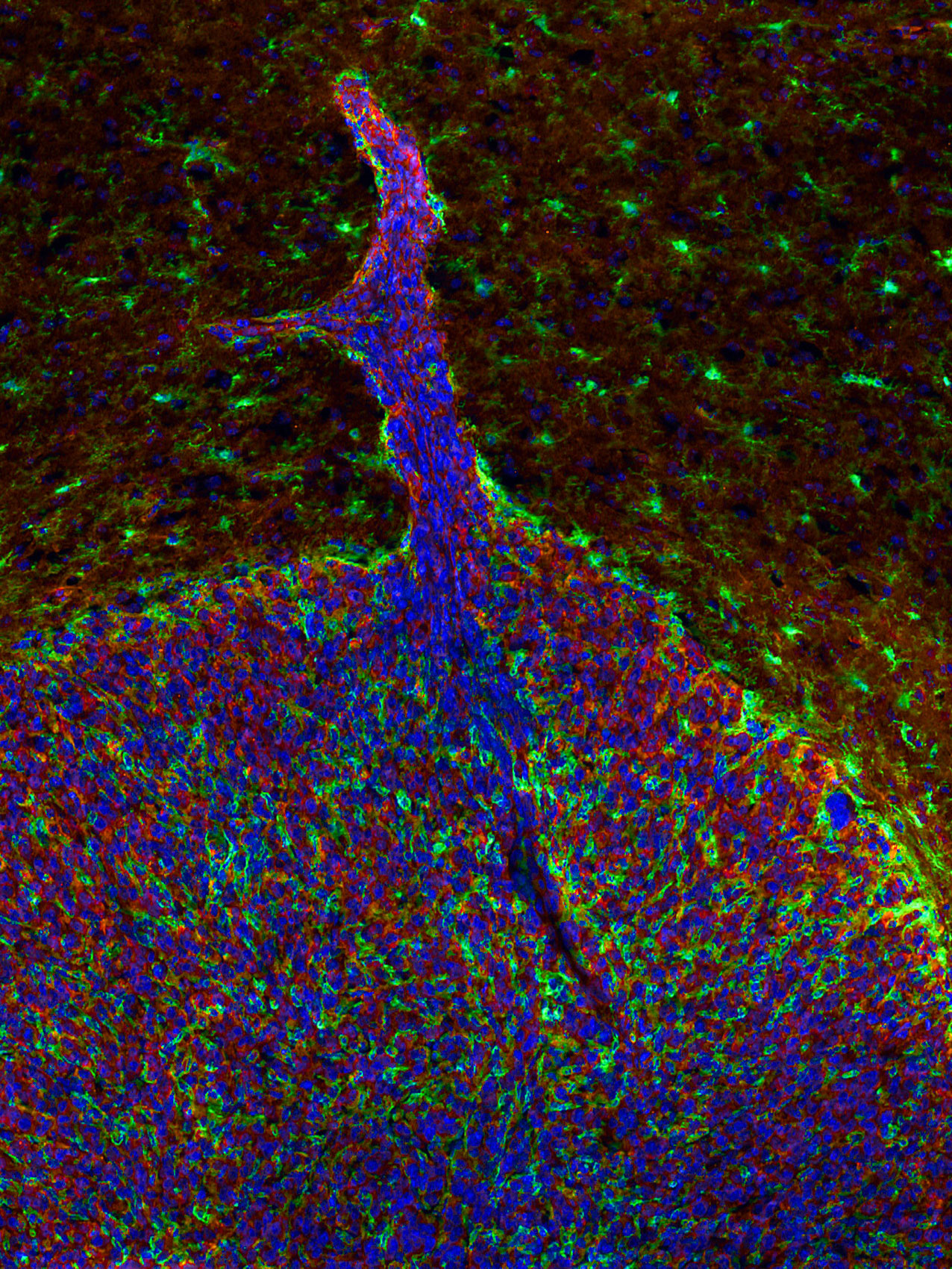
Shalaka Wahane, PhD
Nash Family Department of Neuroscience
Hand of Tumors
A glioblastoma progressing through the brain parenchyma utilizing the brain’s vascular structure (not imaged here). The myeloid cells stand guard outside as well as inside the tumour.
Shalaka Wahane, PhD
Waveform
Nash Family Department of Neuroscience
The mouse brain cerebellum imaged for the Purkinje neurons and long, dense Bergmann Glia.
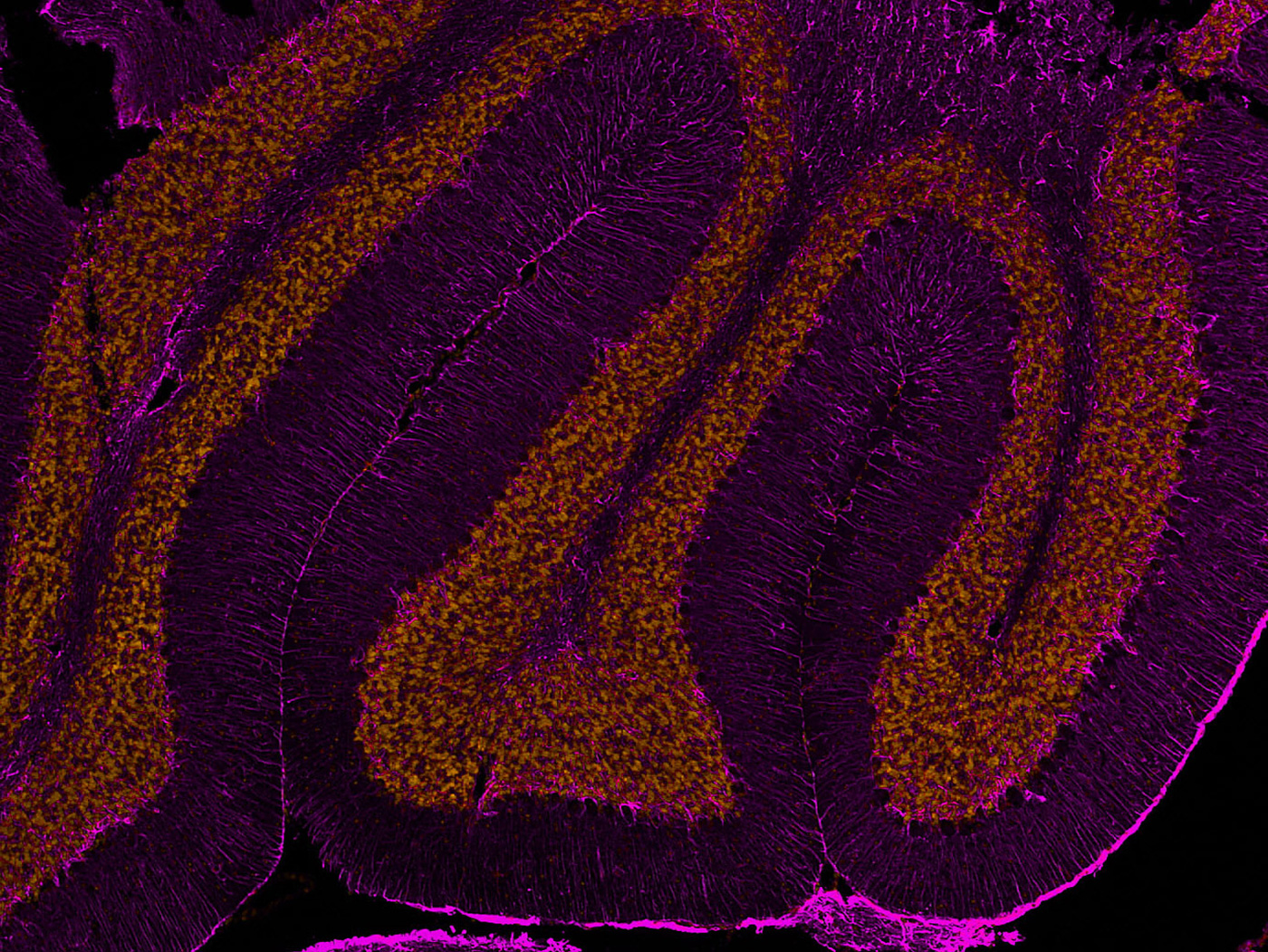
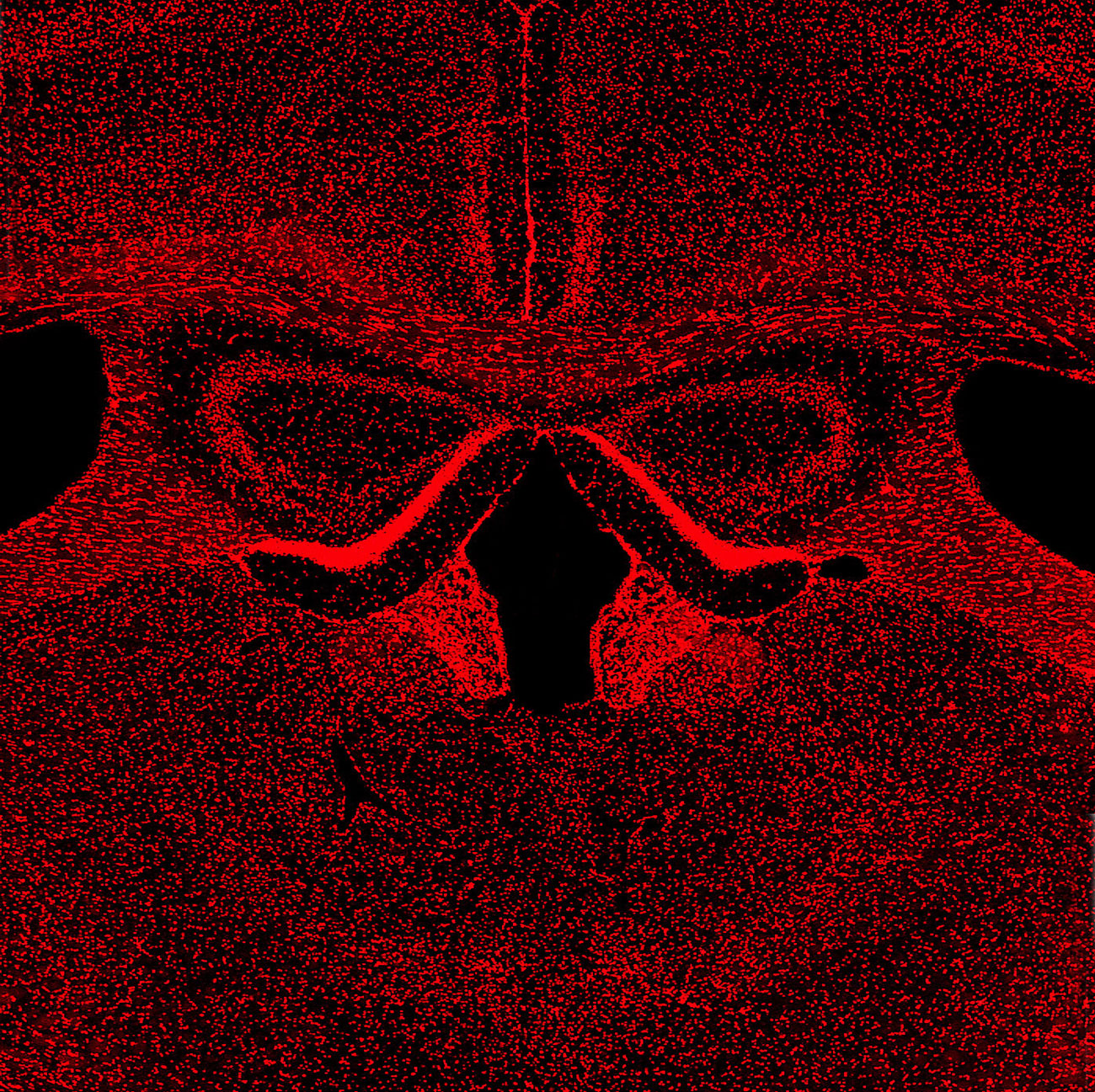
Shalaka Wahane, PhD
Nash Family Department of Neuroscience
Darth Matter
Nuclei from the adult murine Hippocampus imaged using DAPI.
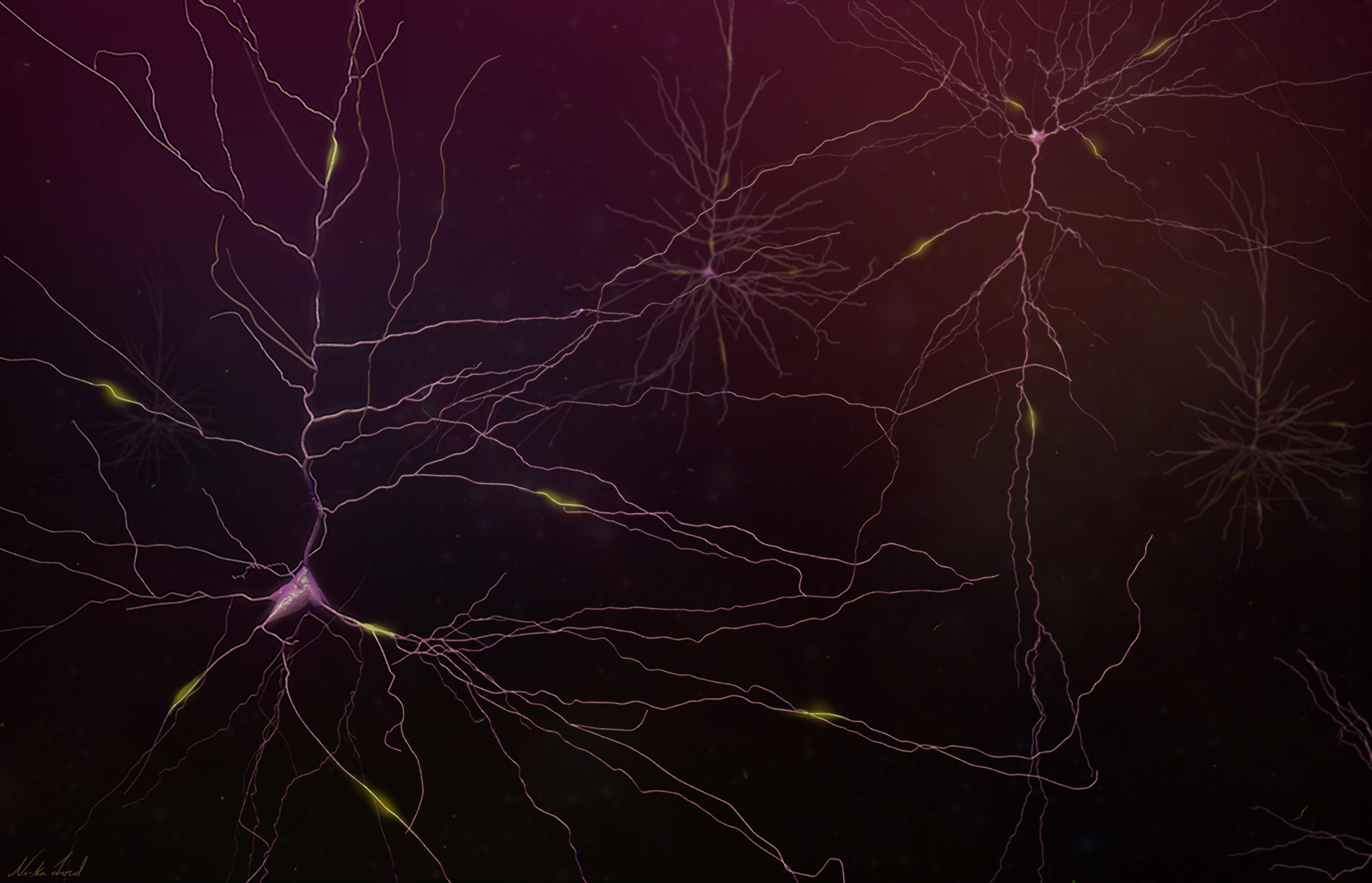
Ni-Ka Ford
Instructional Technology Group
Inside the Neocortex
A prominent neuron found in the neocortex is the pyramidal neuron. It is located in subcortical structures such as the hippocampus and the amygdala. This image strives to capture the intricate beauty and bountifulness of the pyramidal neuron which is responsible for many important cognitive processes. The neurons were generated from data of human pyramidal cells from NeuroMorpho.org and imported into Cinema 4D as accurate 3D models. The image was composited further in photoshop for the finishing touches such as the neural signaling and
atmospheric perspective.
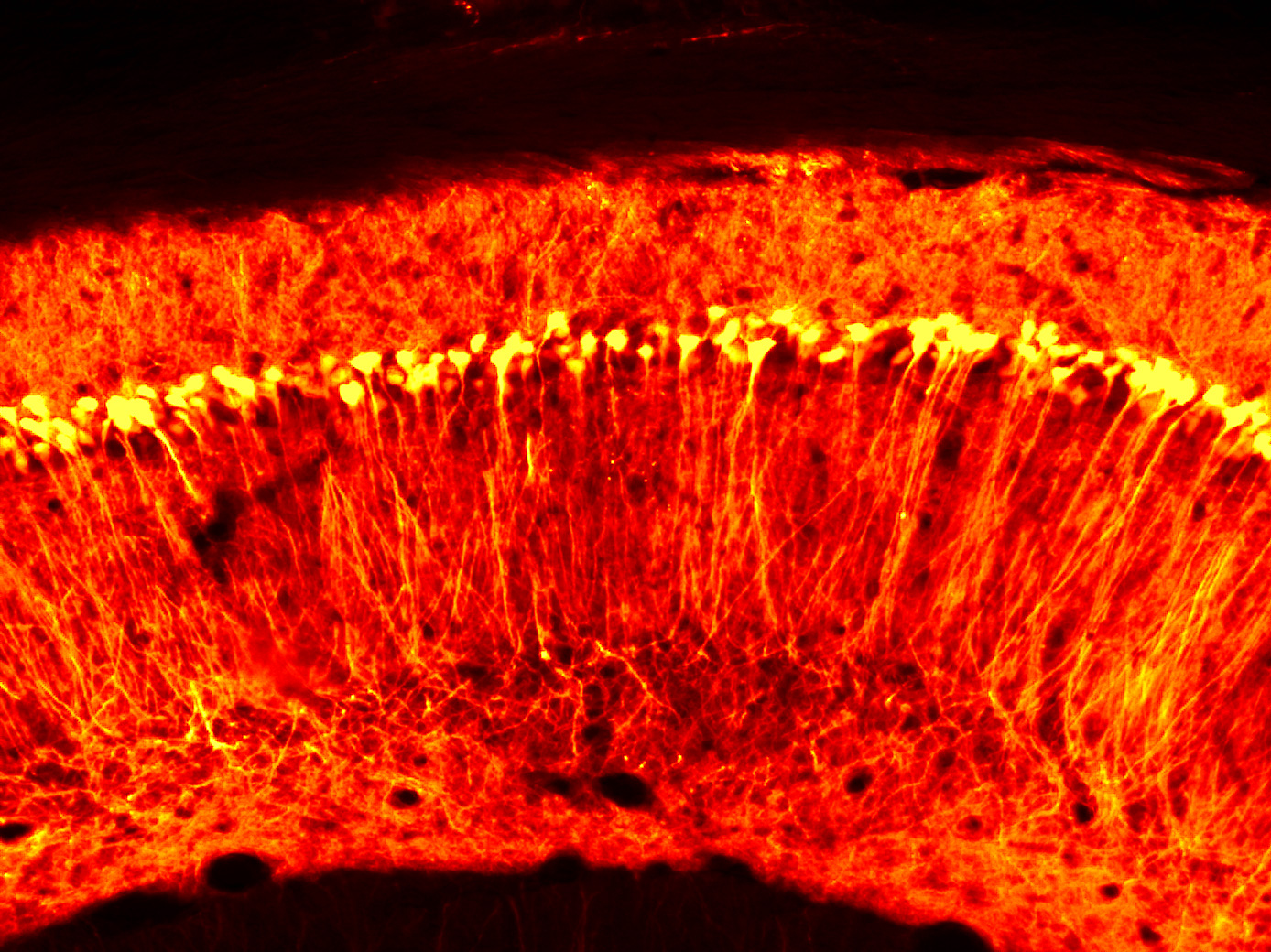
Anthony Lacagnina, PhD
Nash Family Department of Neuroscience
Fear memory-related neurons
Using an activity-dependent tagging genetic mouse (the ArcCre mouse), neurons that were
active during a contextual fear conditioning session were permanently tagged with a fluorescent reporter. These are hippocampal CA1 neurons that were active during that fearful experience.
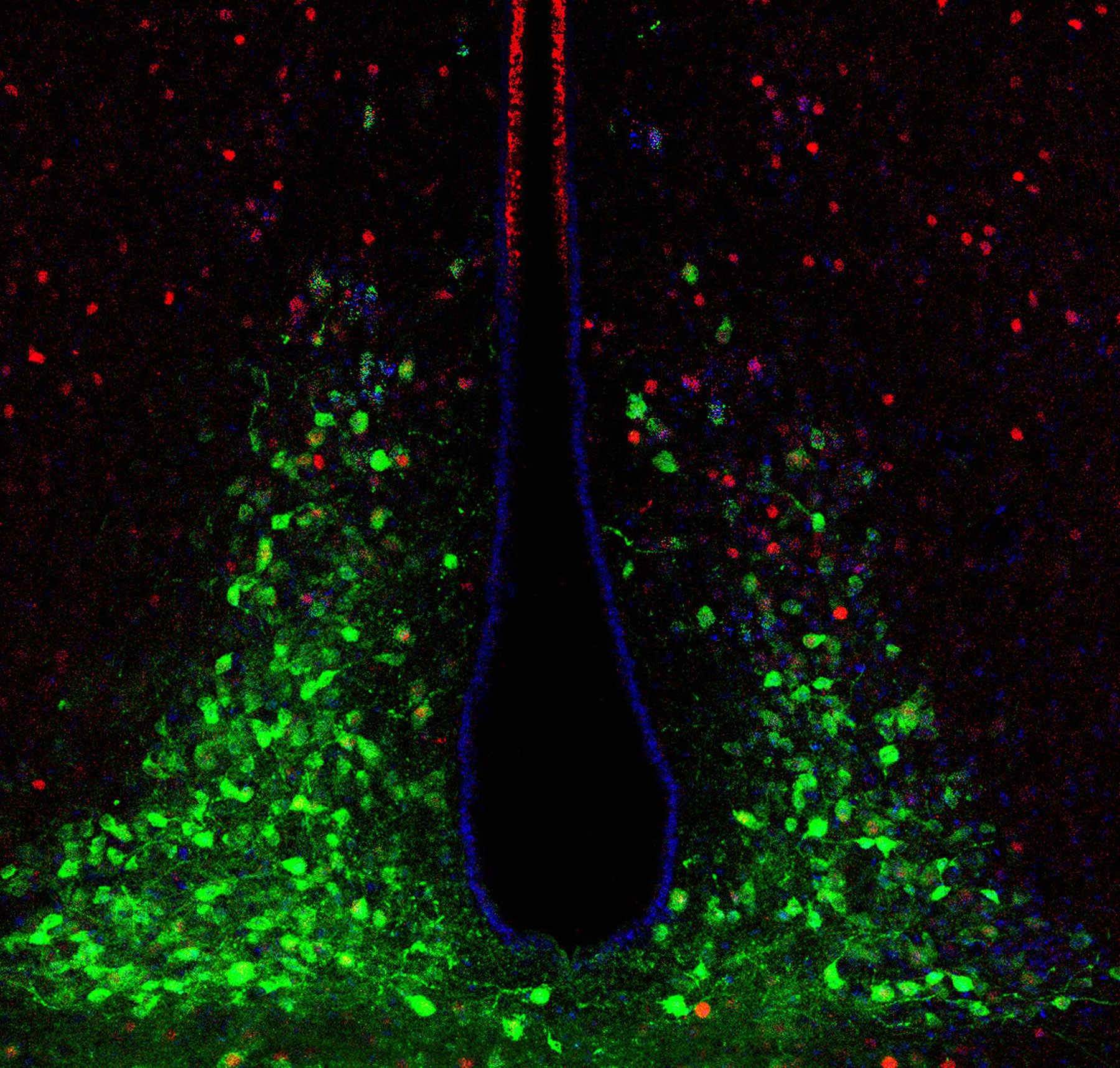
Long Li, PhD
Nash Family Department of Neuroscience
Christmas Tree
Cfos and oxytocin expression pattern in PVH region(unside-down) after social behavior.

Chrystian Junqueira Alves, PhD
Nash Family Department of Neuroscience
Golden neurons
Plexin-B2-mediated cell-intrinsic stiffness leading to spontaneous neuronal differentiation upon neural induction. β-III tubulin (TUJ1; gold) and DAPI (blue).
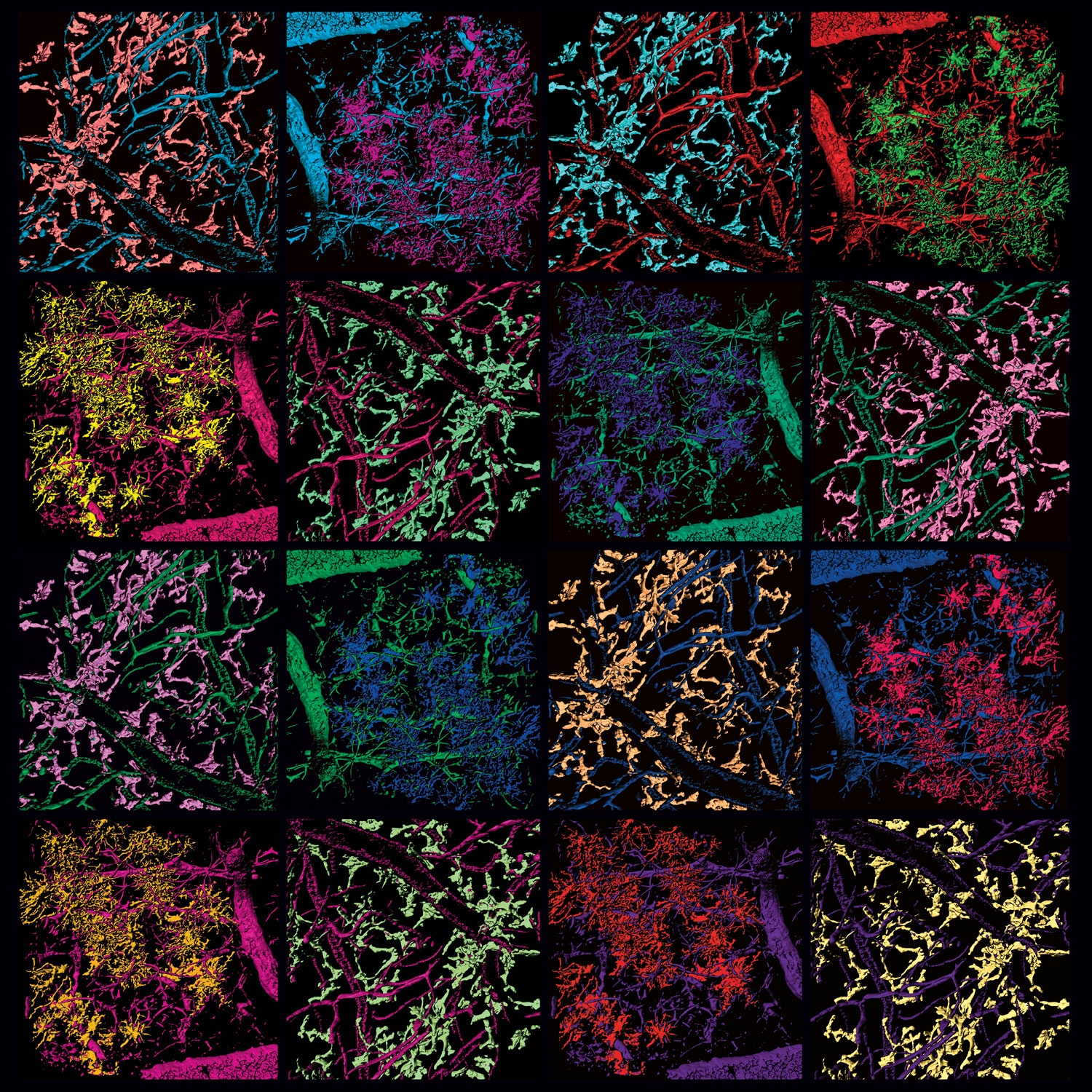
Jillian Beroza; Dolores Hambardzumyan, PhD; Zhihong Chen, PhD
Department of Neurosurgery
Macrophages Clinging Mashup
The image shows tumor-associated macrophages clinging to the blood vessels in glioblastoma. These macrophages derive from either brain microglia (the bushy ones) or circulating monocytes (the rounder ones), and they behave differently in tumor development.
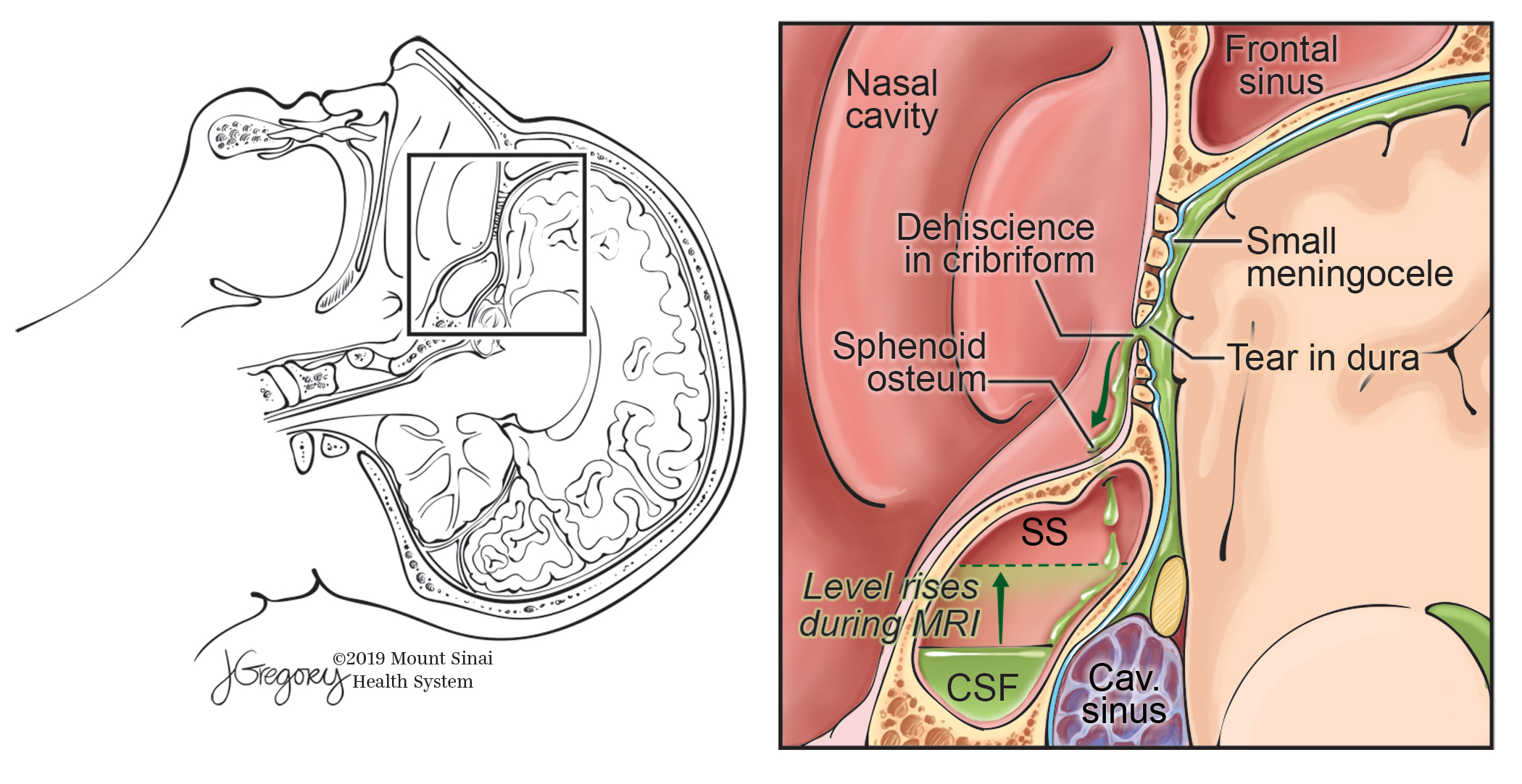
Jill K Gregory, CMI, FAMI
Instructional Technology Group
CSF Leak through the Cribriform Plate
Cerebrospinal Fluid (CSF) leakage is a potentially fatal condition that may result when a skull base dural defect permits CSF communication between the cranial vault and sinonasal cavities. Flow rate is an important property of CSF leaks that can contribute to surgical decision-making and predispose patients to complications and inferior outcomes. This illustration depicts a dural tear along with cribriform dehiscence that allows CSF to trickle into the sinonasal cavity. Middle and posterior cribriform leaks tend to pool in the sphenoid sinus (SS), which is measurable by the change in fluid level during the course of an imaging session. This provides a non-invasive means to measure CSF flow rate. This illustration appears in the Journal of Neurosurgery, in the article “Correlation of spontaneous and traumatic anterior skull base CSF leak flow rates with fluid pattern on early, delayed, and subtraction volumetric extended echo train T2-weighted MRI” by Rutland et al.
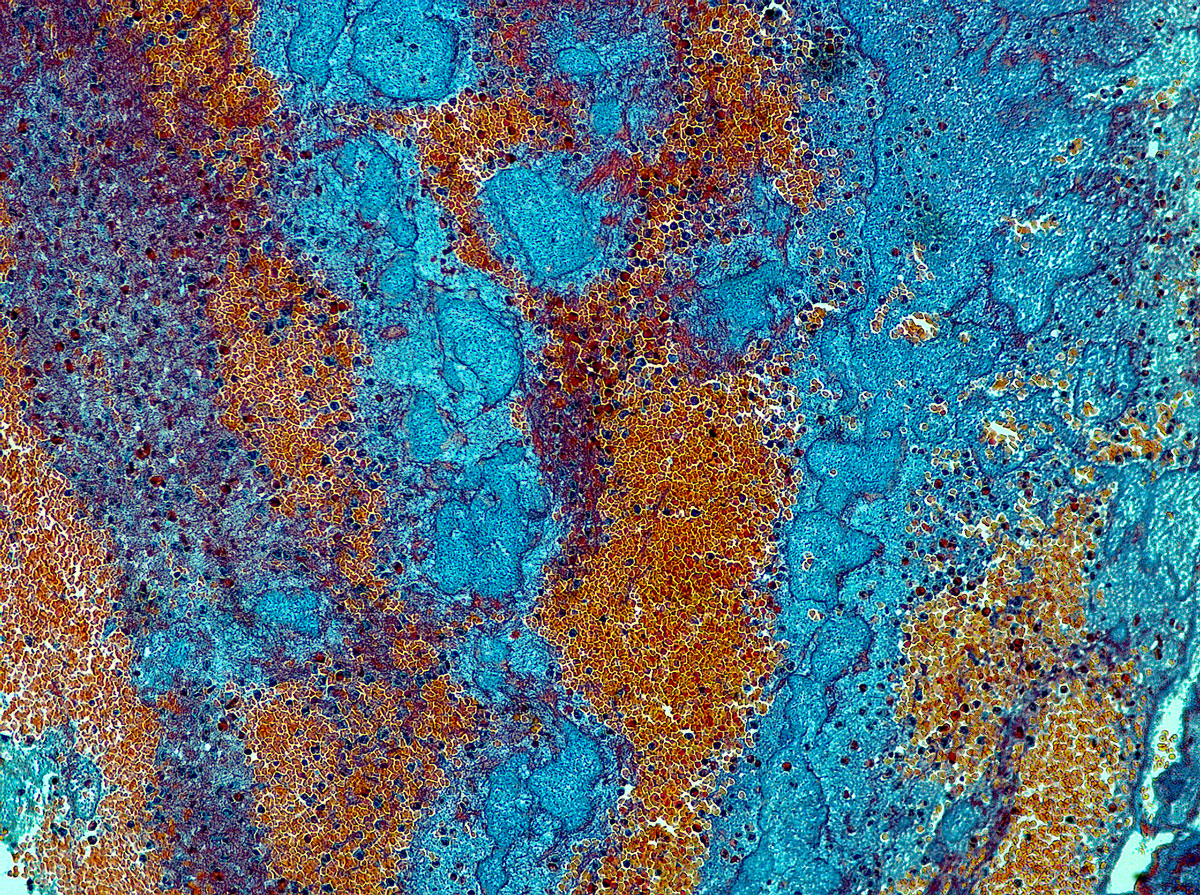
James Vicari, (Kellner Lab)
Department of Neurosurgery
The Deadly Wanderer
This image is of a human acute ischemic stroke clot using MSB trichrome staining to
visualize RBC, WBC, platelet and fibrin composition in stroke clots.

Holly Oemke Madarash
Department of Neurosurgery
Escape
Recolored 3D visualization of a patient’s brain anatomy.

Genoveva Uzunova, MD, PhD
Department of Pathology
Glioblastoma cells braid
Phase contrast photomicrograph of primary human glioblastoma cells dissociated from a
tumor obtained at surgery and grown for 2 weeks in vitro in cell culture. The image is taken with the new Leica PAULA imaging system.

Estrella Lopez-Gordo, PhD
Department of Cardiology
When science meets art in a mouse brain
This image illustrates the brain of a healthy adult CMAH knock-out female mouse. The diversity and dynamism of structures in the depicted brain shows us how science can both educate us and inspire us to find beauty beyond the obvious. Maakia amurensis II (MALII) staining in blue and nuclei in pink. Magnification 5x.
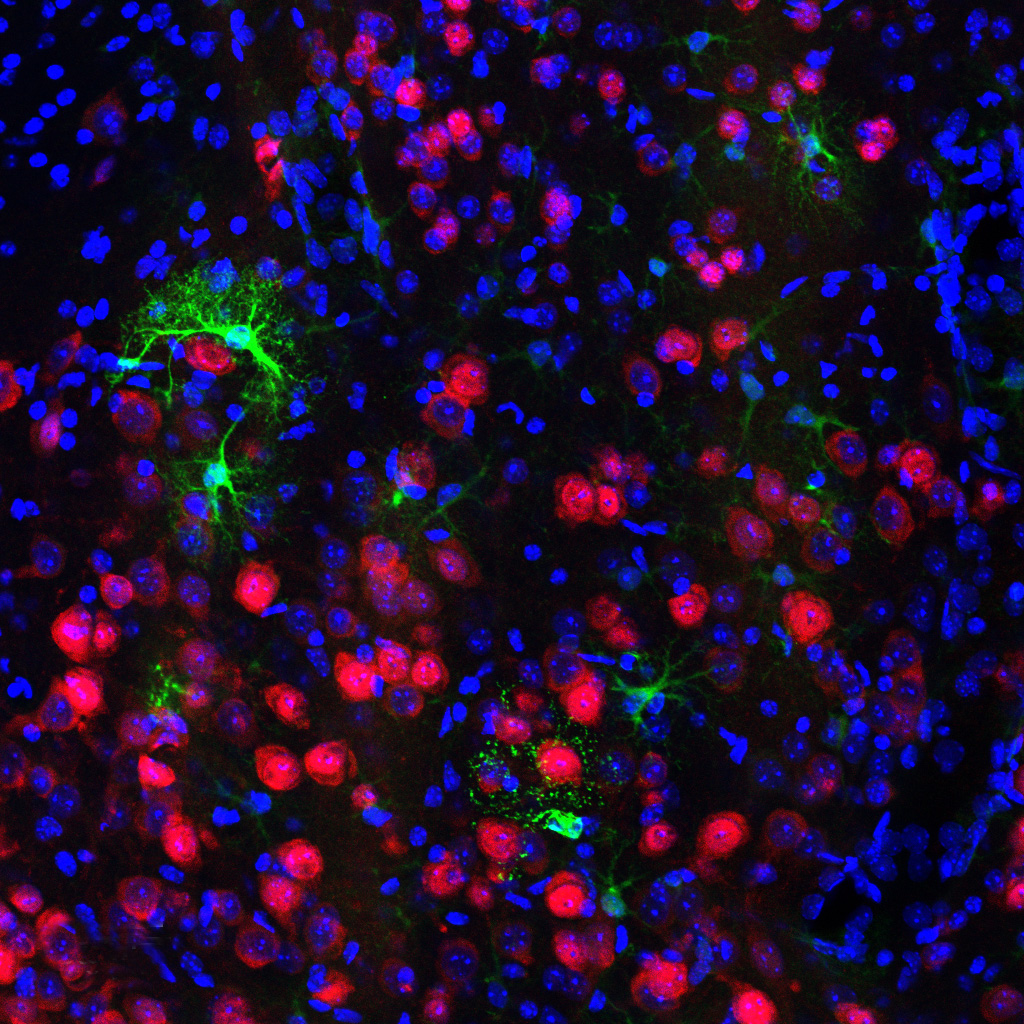
Eric Parise, PhD
Nash Family Department of Neuroscience
Virally targeted astrocytes within the nucleus accumbens
Astrocytes (star-shaped support cells of the brain that are influenced by stress and
depression) labeled with a virus expressing green fluorescent protein (GFP) in a deep brain reward center of mice. Astrocytes are in green; Neurons are in red; and Cell nuclei, are in blue.
Click to purchase and donate to the DiverseBrains Initiative
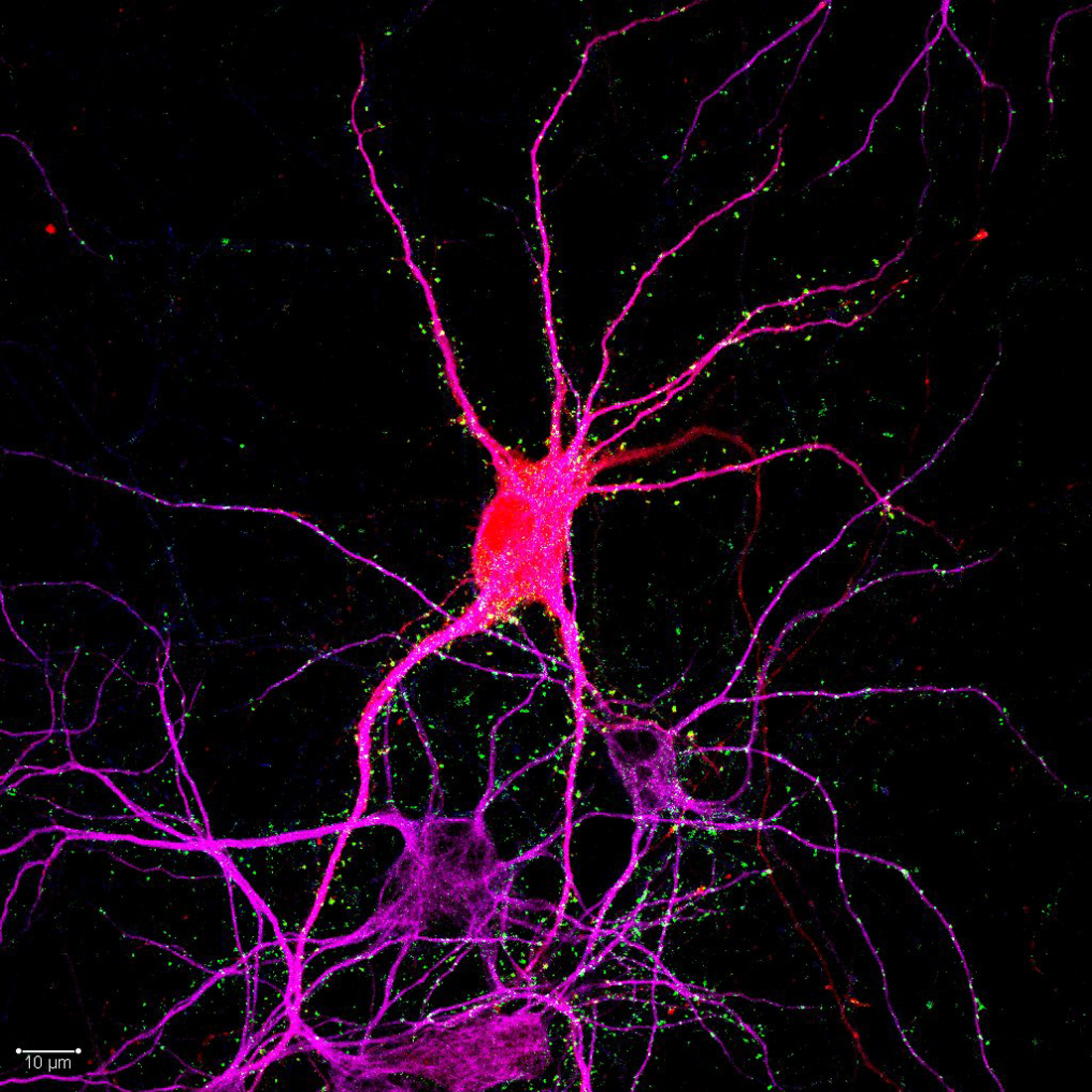
Devina Ung, PhD, Andrea Boitnott and Danielle Mendonca
Department of Psychiatry
Itsy Brainy Spider
Mouse cortical neuron expressing mCherry (red) immunostained for dendritic marker
MAP2 (magenta), synaptic marker PSD95 (green), and axon marker Tau in blue.
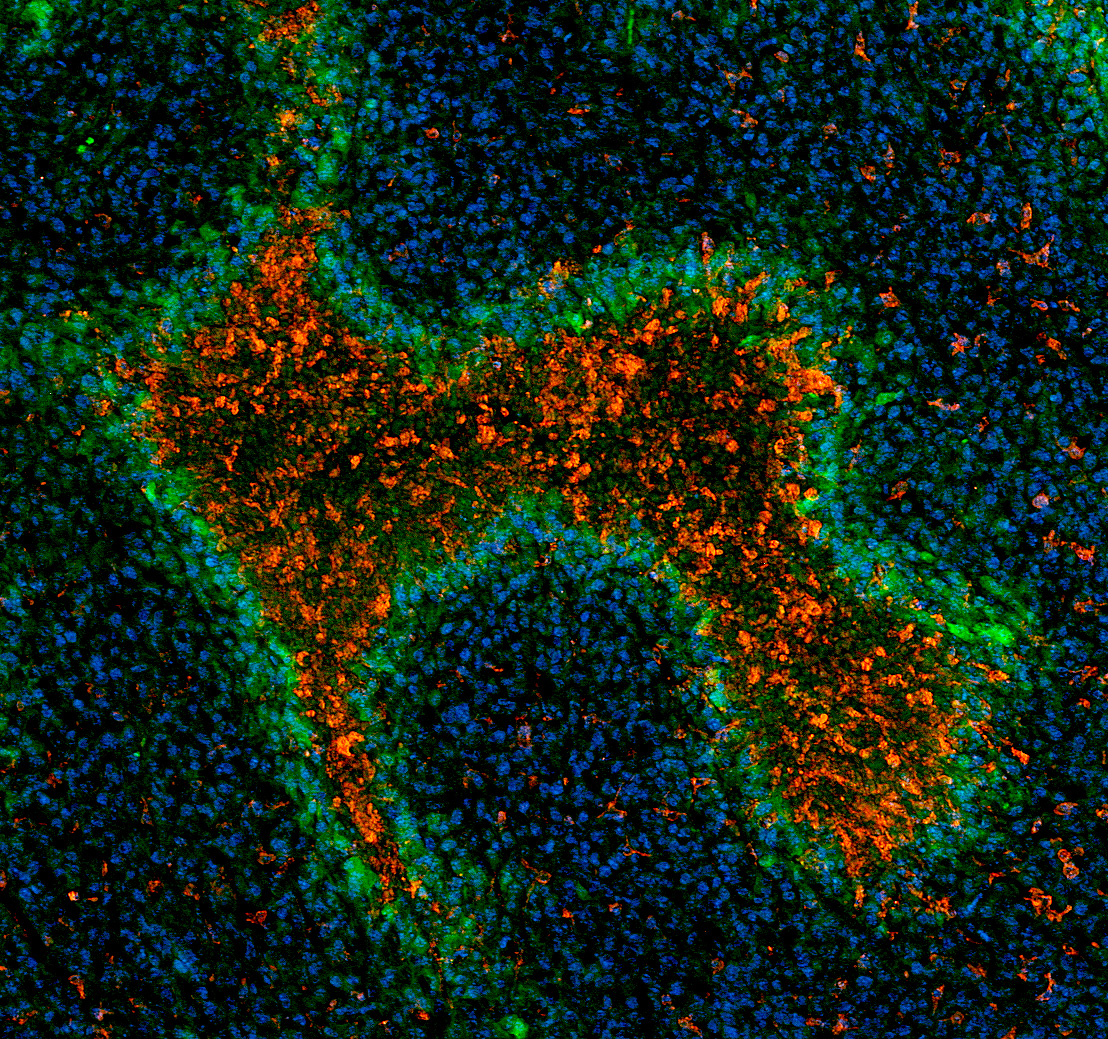
Anirudh Sattiraju, PhD
Nash Family Department of Neuroscience
Scavengers
Macrophages (red) inside a necrotic region of glioblastoma with tumor cells within
surrounding peri-necrotic region expressing a genetic reporter for hypoxia (green).
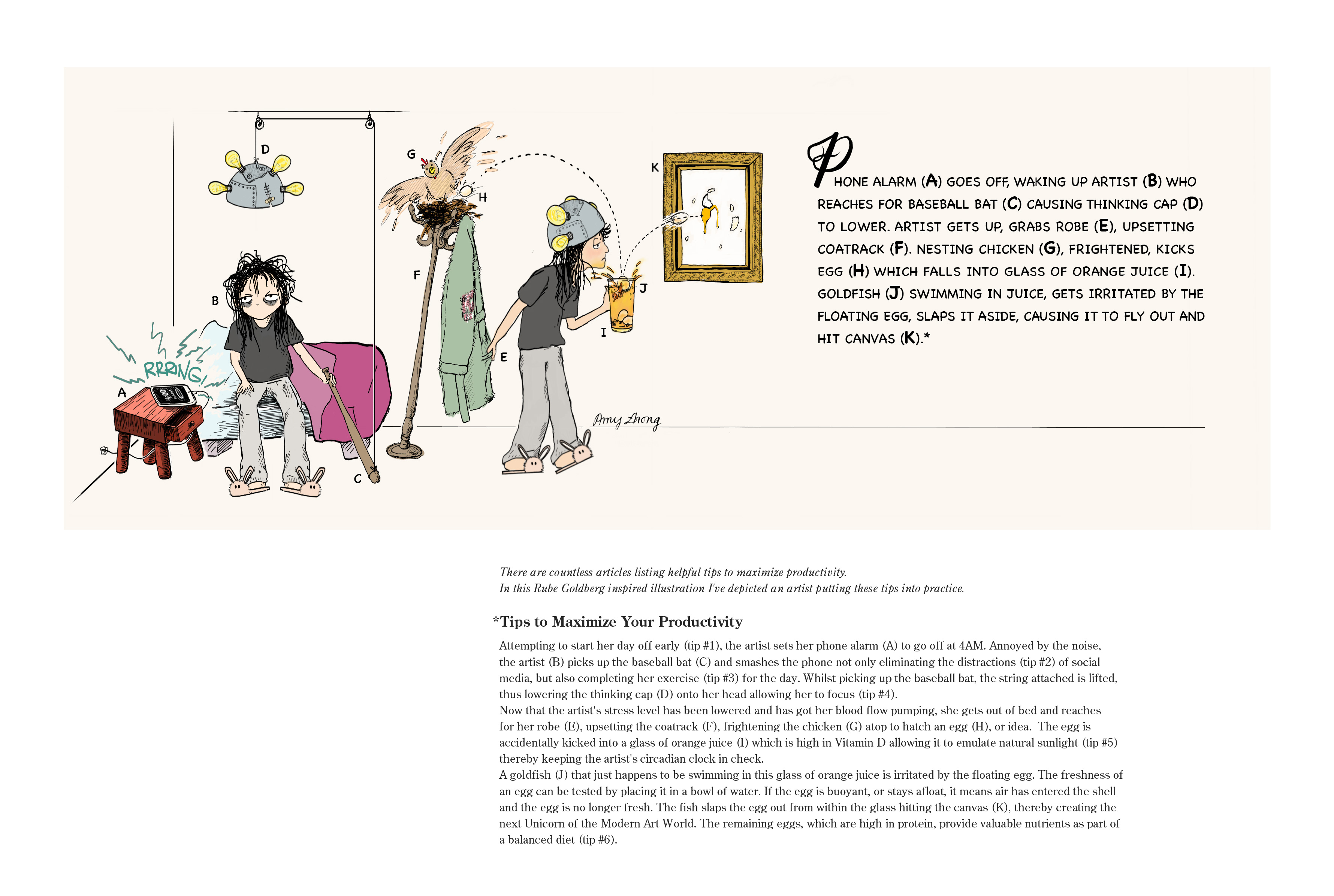
Amy Zhong
Instructional Technology Group
How to Maximize Your Productivity
There are countless articles listing helpful tricks to maximize productivity. In this Rube
Goldberg inspired illustration I’ve depicted an artist putting these tricks into practice. Attempting to start her day off early (tip #1), the artist sets her phone alarm (A) to go off at 4AM. Annoyed by the noise, the artist (B) picks up the baseball bat (C) and smashes the phone not only eliminating the distractions (tip #2) of social media, but also completing her exercise (tip #3) for the day. Whilst picking up the baseball bat, the string attached is lifted,
thus lowering the thinking cap (D) onto her head allowing her to focus (tip #4). Now that the artist’s stress level has been lowered and has got her blood flow pumping, she gets out of bed and reaches for her robe (E), upsetting the coatrack (F), frightening the chicken (G) atop to hatch an egg (H), or idea. The egg is accidentally kicked into a glass of orange juice (I) which is high in Vitamin D allowing it to give off natural sunlight (tip #5) thereby keeping the artist’s circadian clock in check. A goldfish (J) that just happens to be swimming in this glass of orange juice is irritated by the floating egg. The freshness of an egg can be tested by placing it in a bowl of water. If the egg is buoyant, or stays afloat, it means air has entered the shell and the egg is no longer fresh. The fish slaps the egg out from within the \glass hitting the canvas (K), thereby creating the next Unicorn of the Modern Art World.
The remaining eggs, which are high in protein, provide valuable nutrients as part of a balanced diet (tip #6).
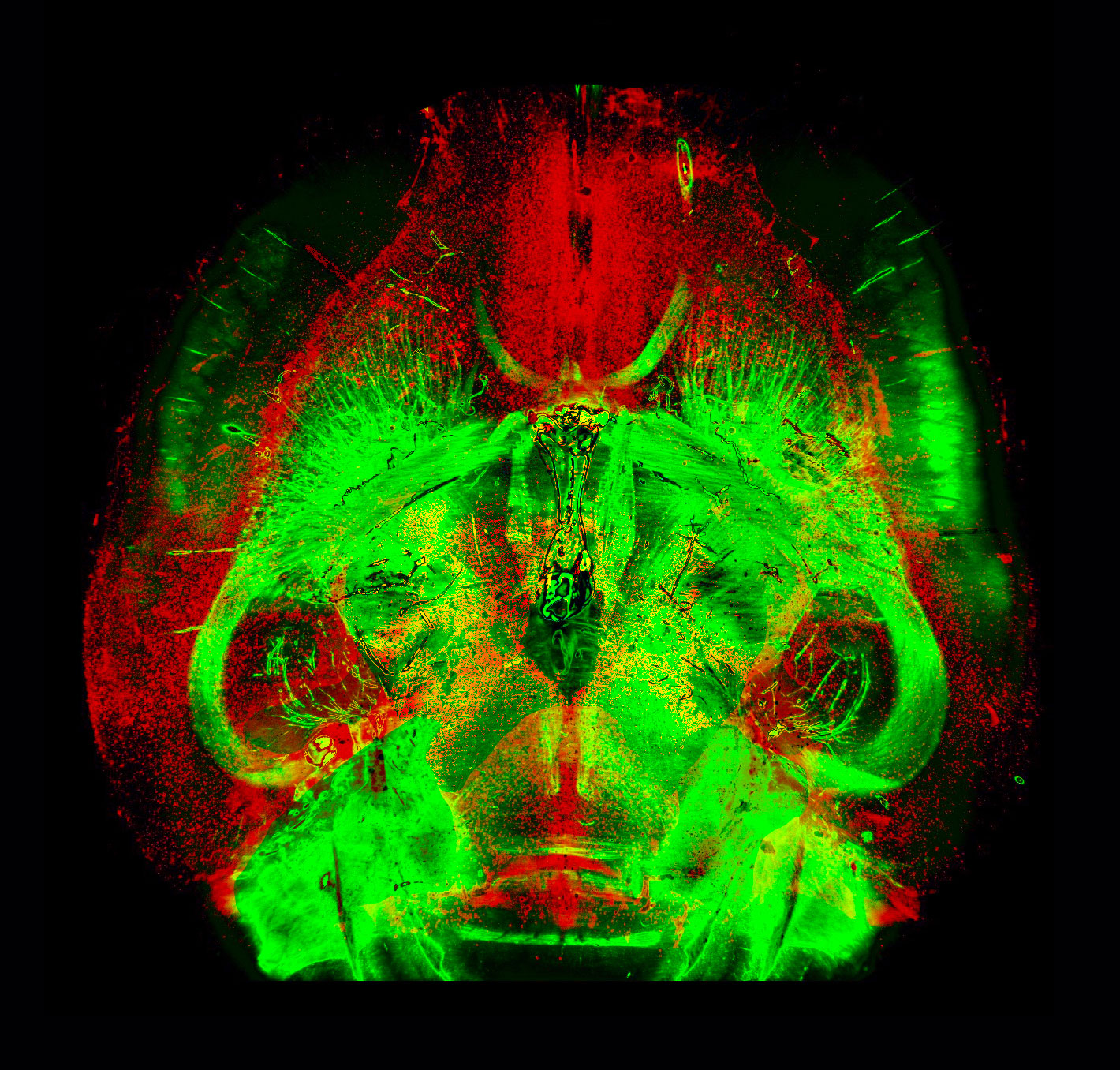
Alexander Smith, PhD
Nash Family Department of Neuroscience
Reward on the Brain
This is an image of a cleared mouse brain, with the green channel representing
autofluorescence, primarily in white matter axon tracts. The red channel is immunofluorescence indicating c-Fos immunoreactivity, showing cells that were activated following a novel reward learning task.
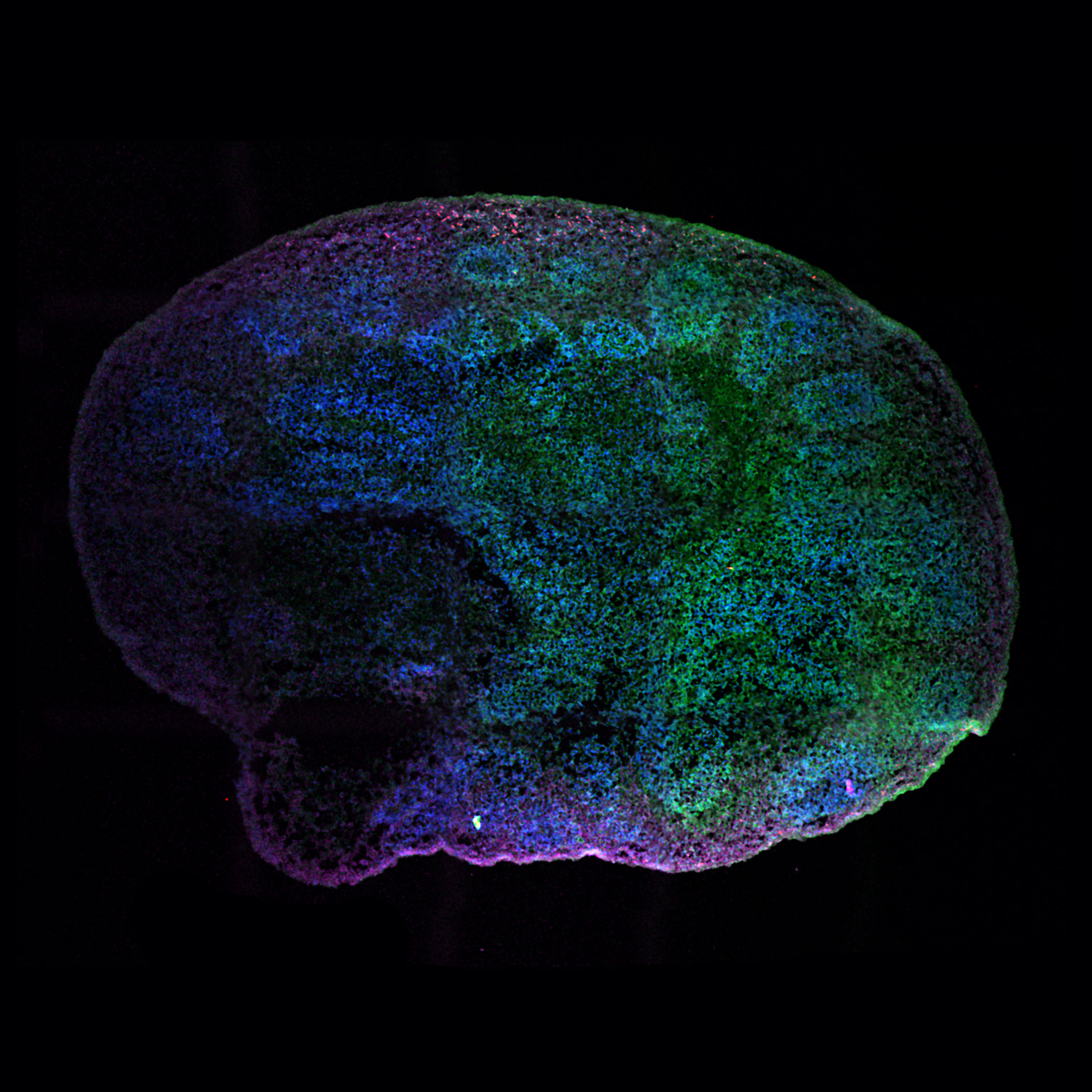
Esther Cheng
Nash Family Department of Neuroscience
Cerebral Brain Organoid
Immunocytochemistry of a cerebral brain organoid cultured from induced pluripotent stem cells.

Jean-Vianney Haure-Mirande, PhD
Department of Neurology
Astrocytes around Amyloid plaque
GFAP positive astrocytes (green) recruited around Aß plaque (red) in the APP/PS1 mouse
model of Alzheimer’s pathology.
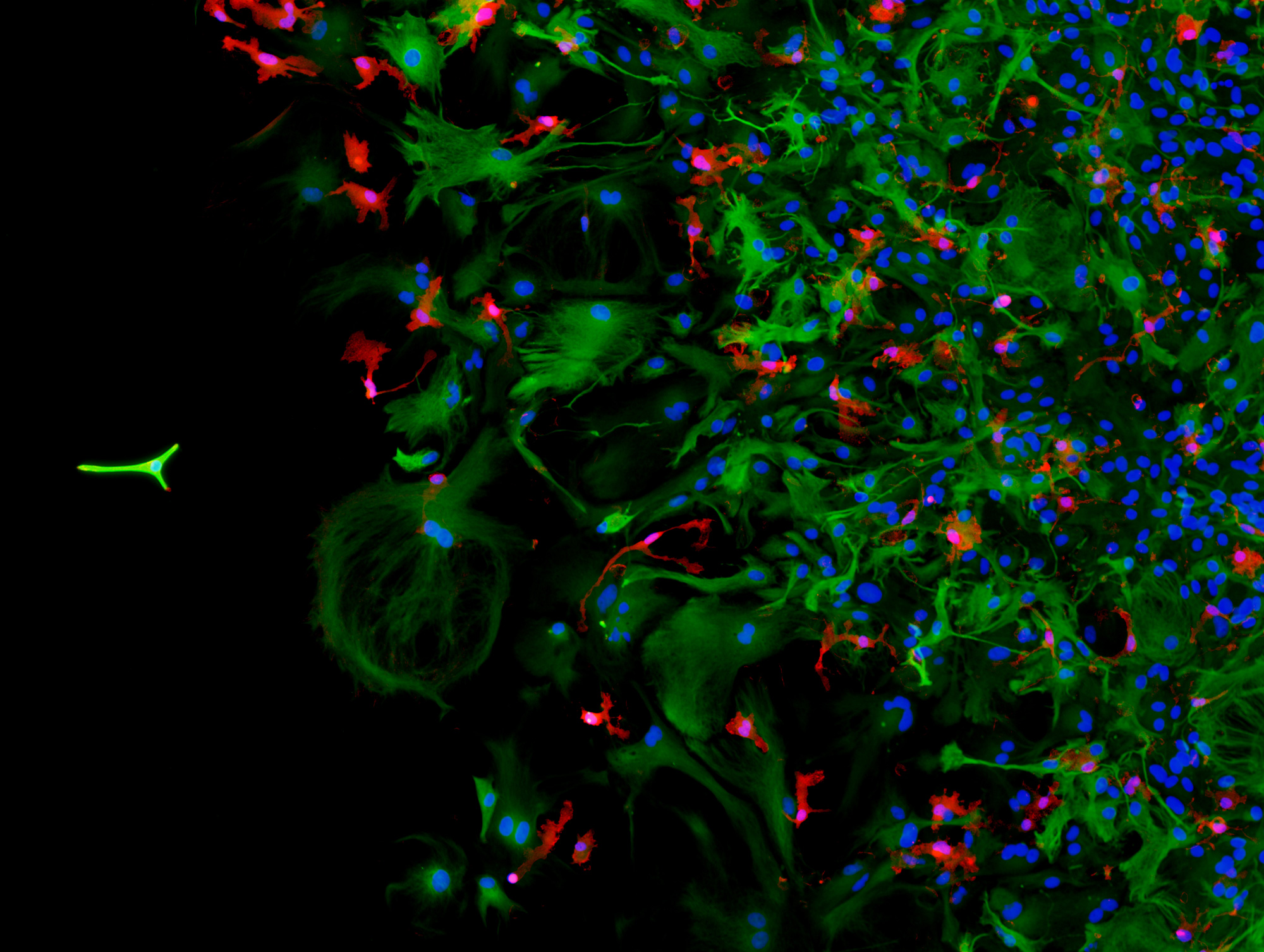
Mickael Audrain, PhD
Department of Neurology
The U.S. Border
Primary microglia and astrocytes.
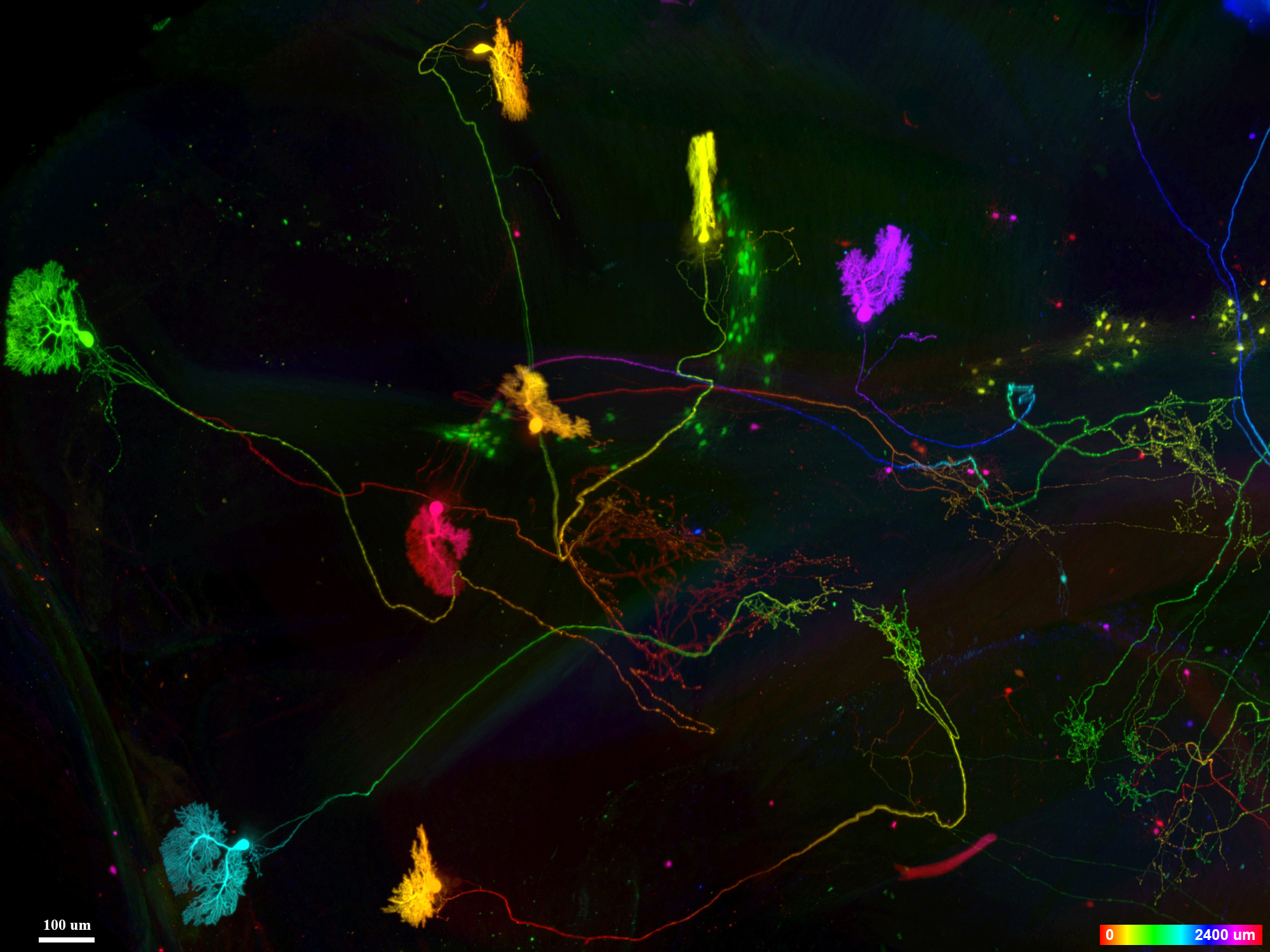
Zhuhao Wu, PhD
Department of Cell, Developmental and Regenerative Biology
Cerebellar Purkinje Cell Projections in 3D
This picture is a volume imaging of sparsely labeled Purkinje cells in an adult mouse brain to reveal their full morphology in 3D. Color indicates the image depth (bottom right scale). The whole tissue was rendered optically transparent with iDISCO techniques and imaged with light-sheet fluorescent microscope to visualize individual Purkinje neurons for their entire long and curved projections from the cell bodies near the surface of the cerebellum to the deep cerebellar nuclei.
The Friedman Brain Institute
One Gustave L. Levy Pl, New York, NY 10029
Contact: Veronica Szarejko (veronica.szarejko@mssm.edu)
#ArtoftheBrain

